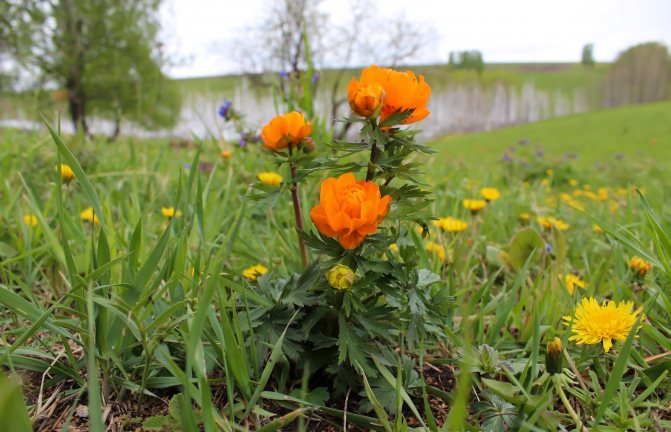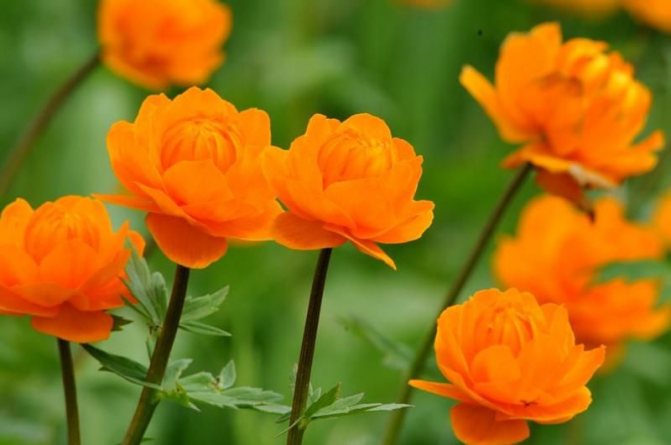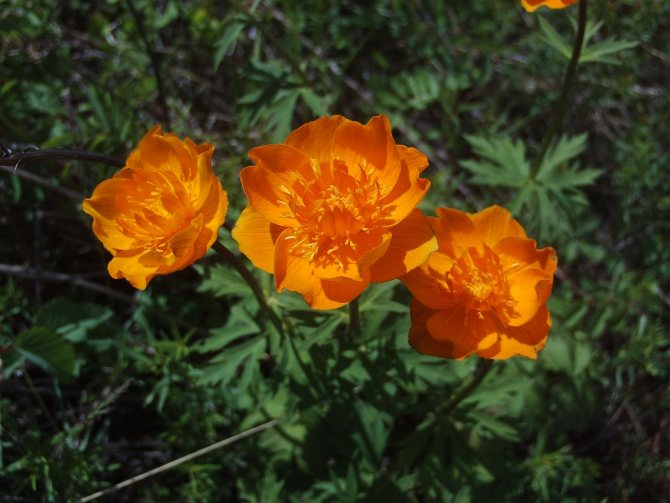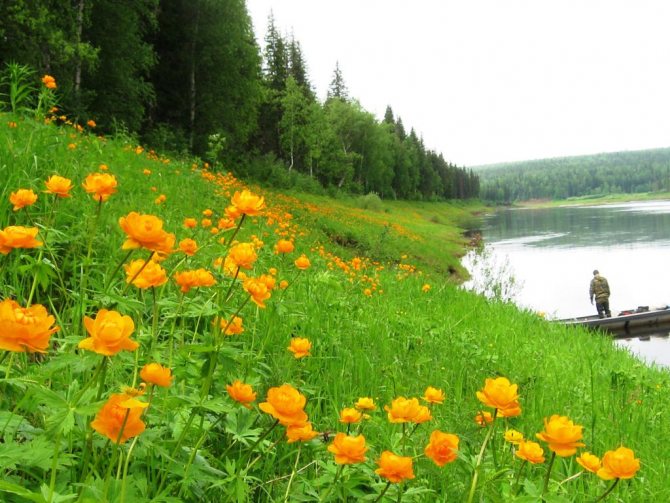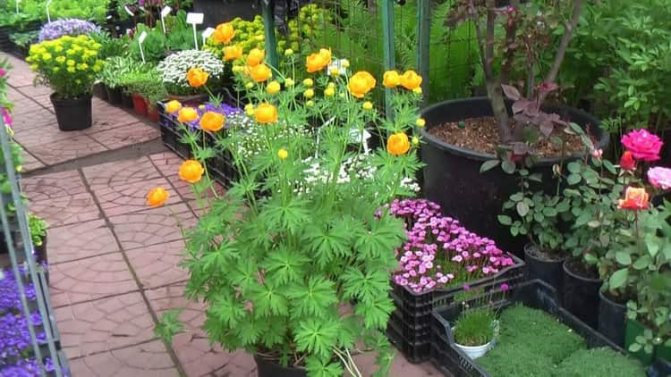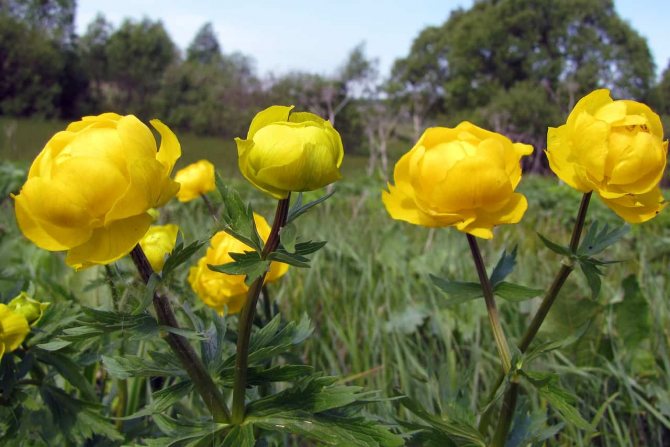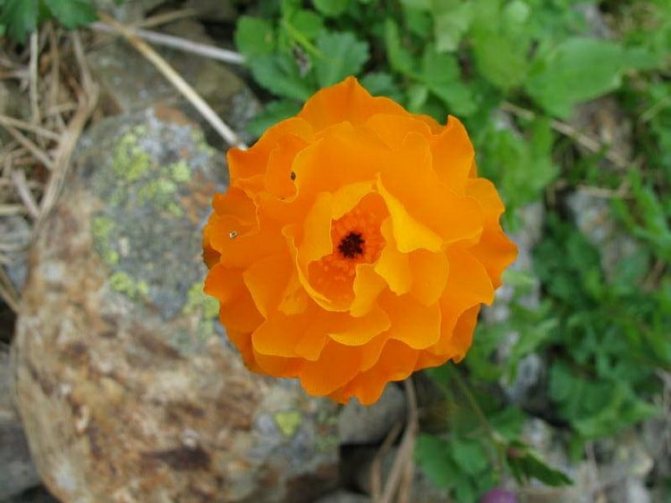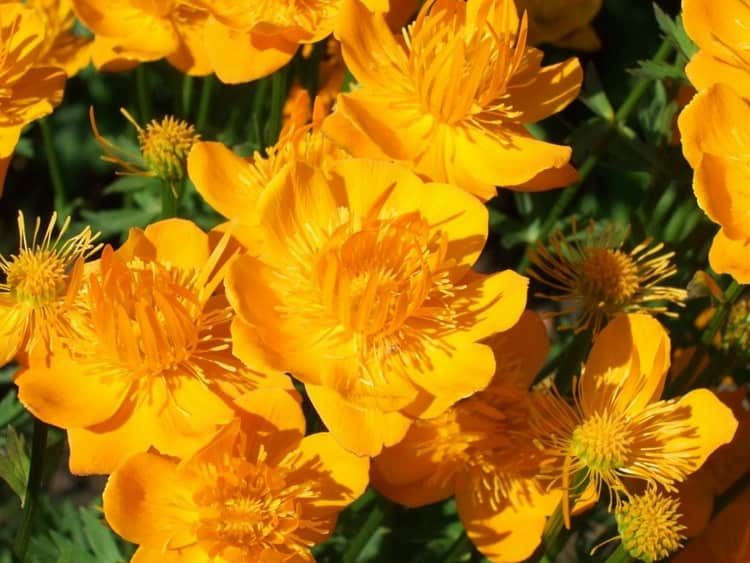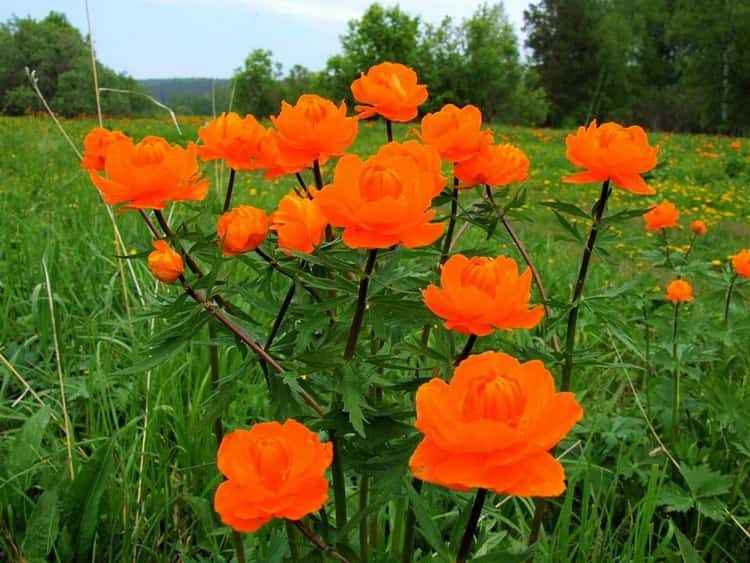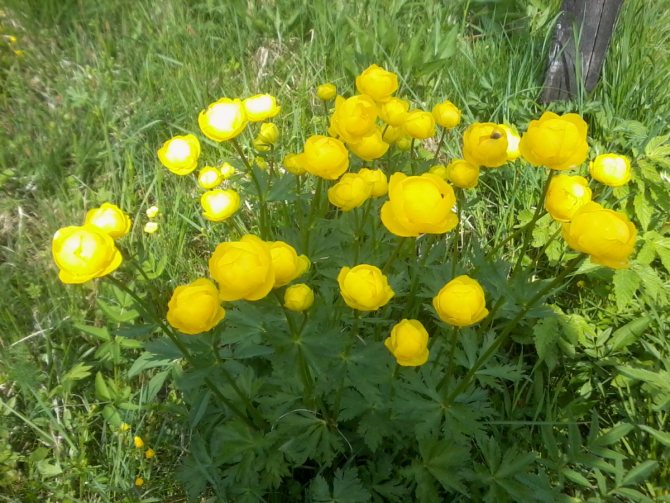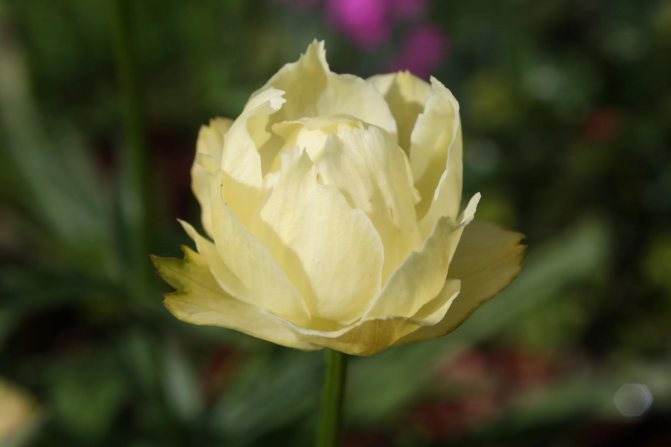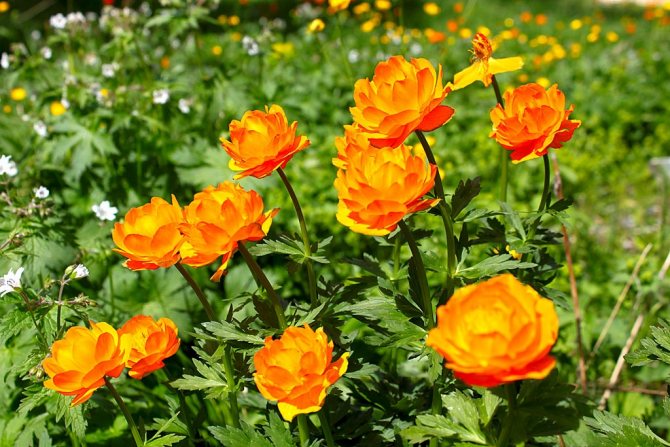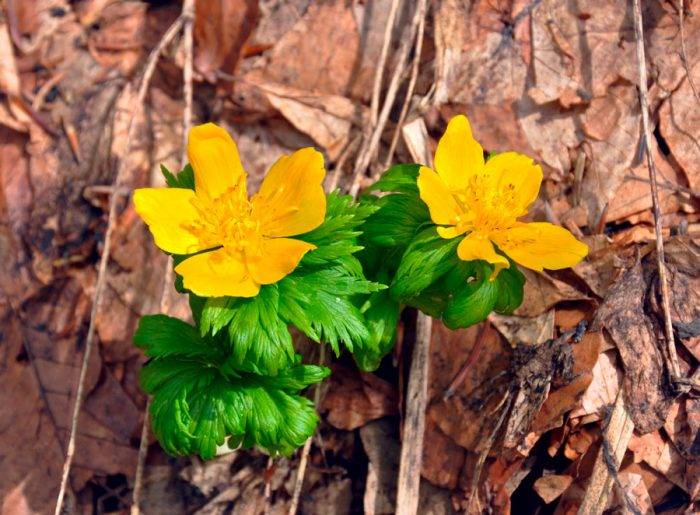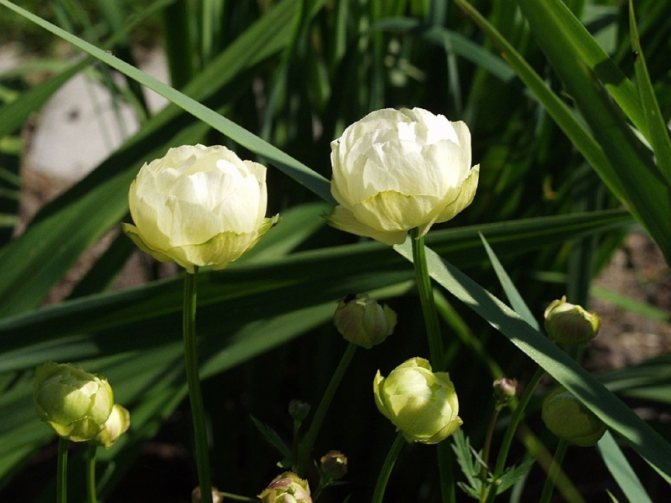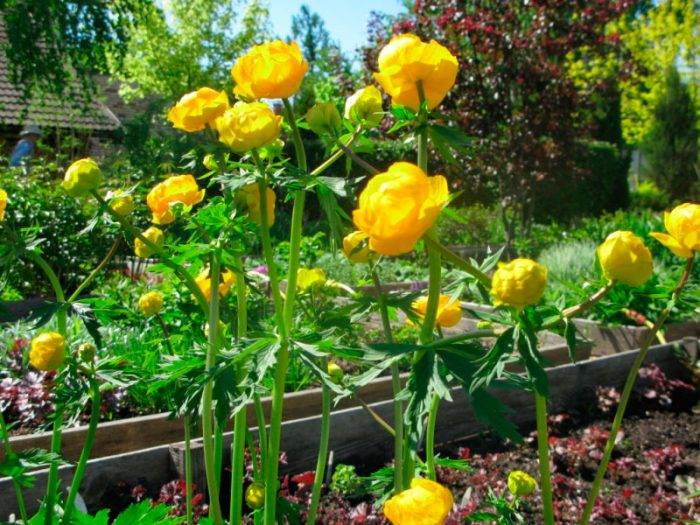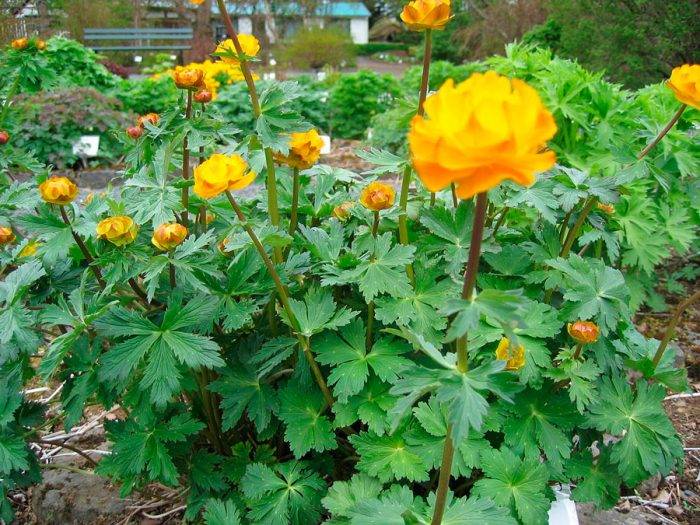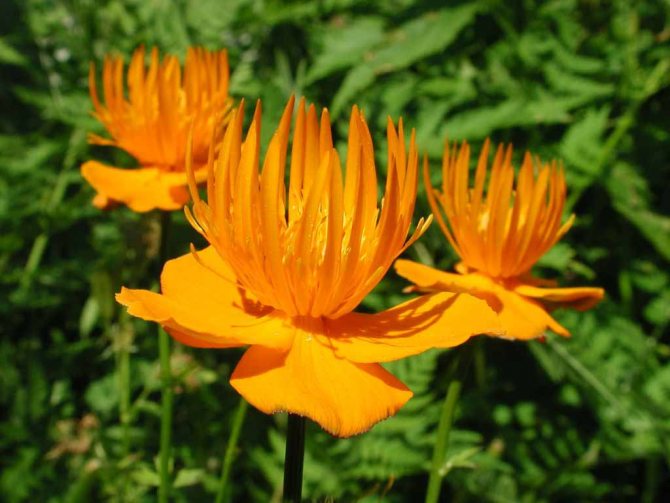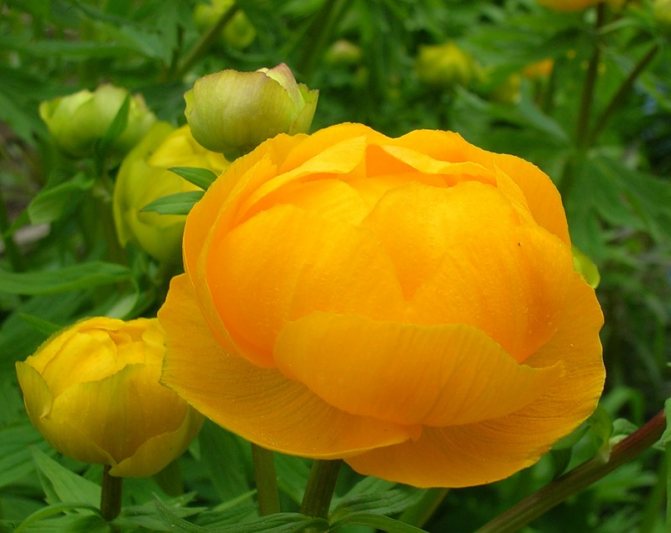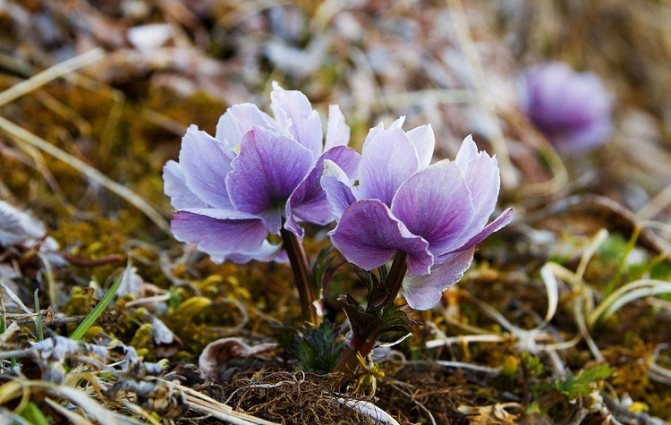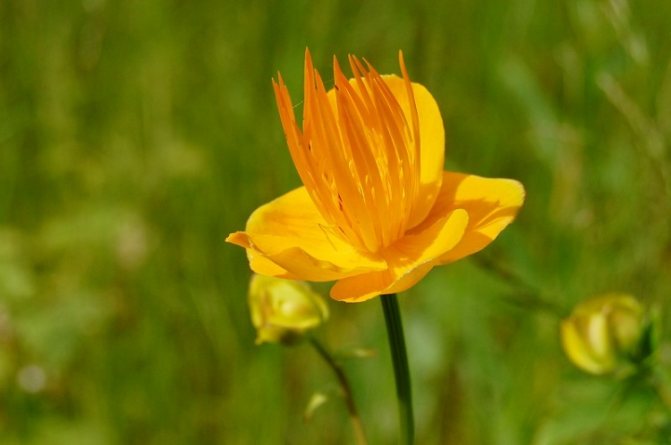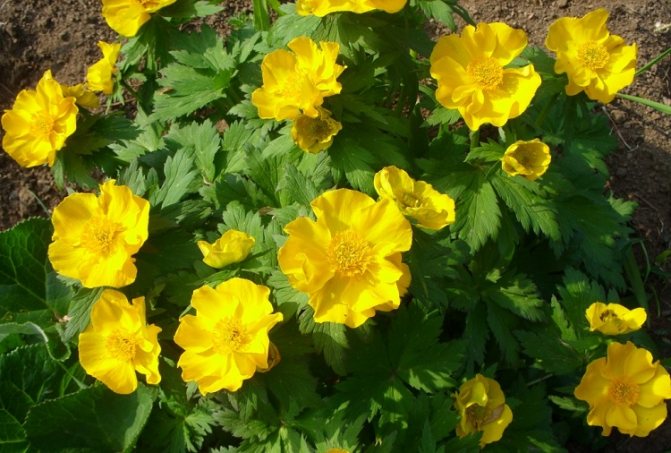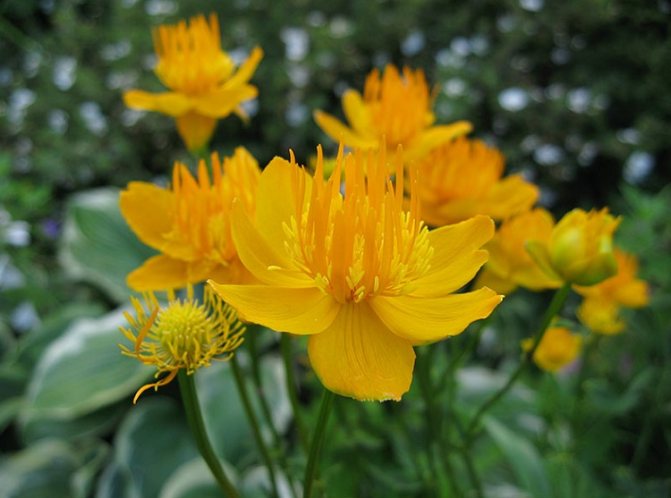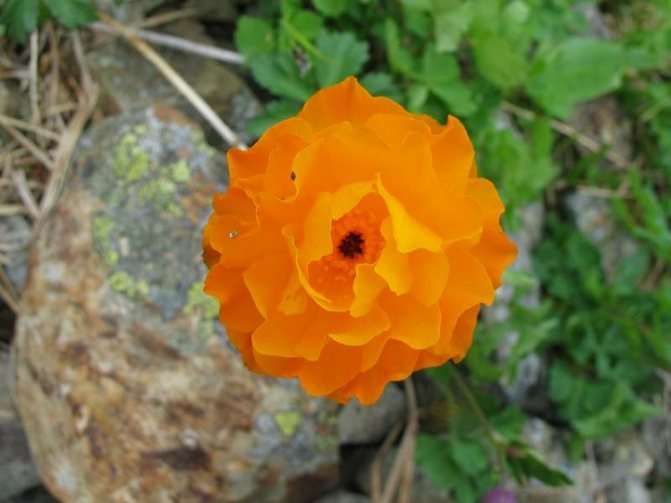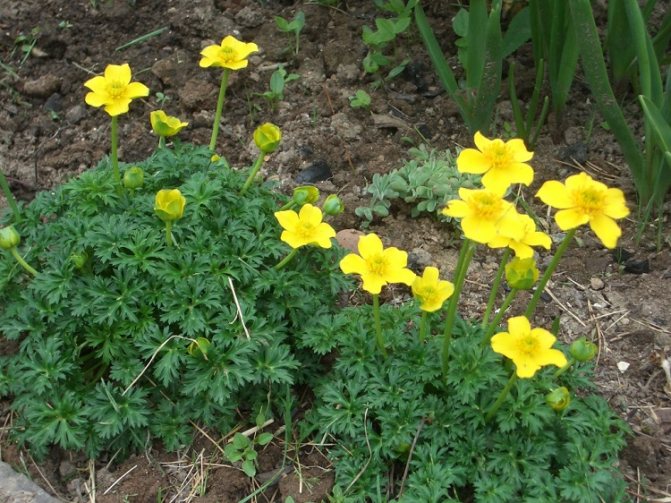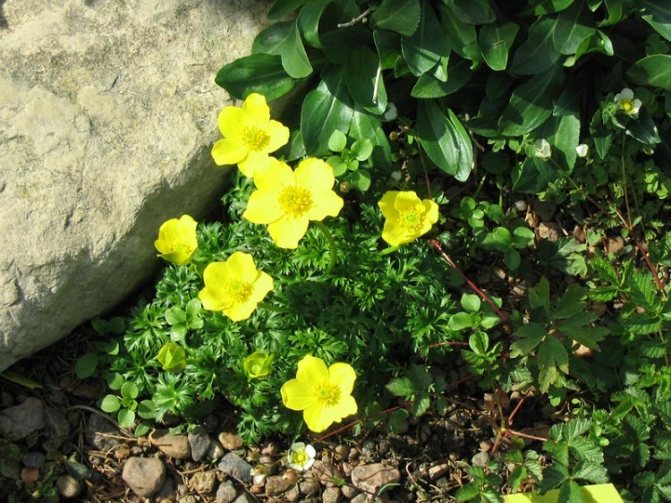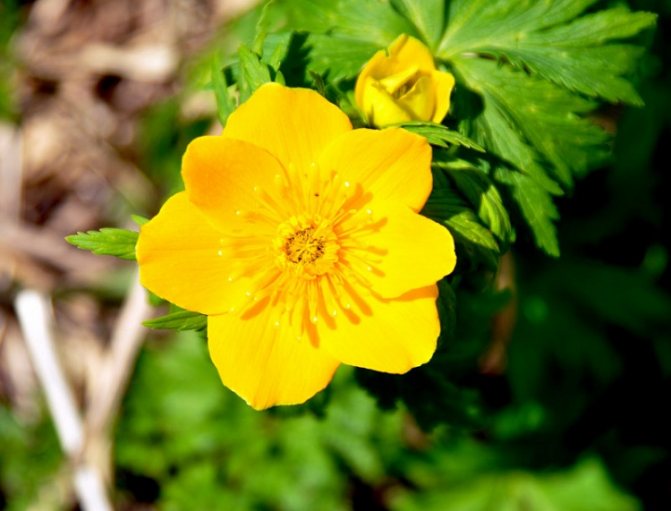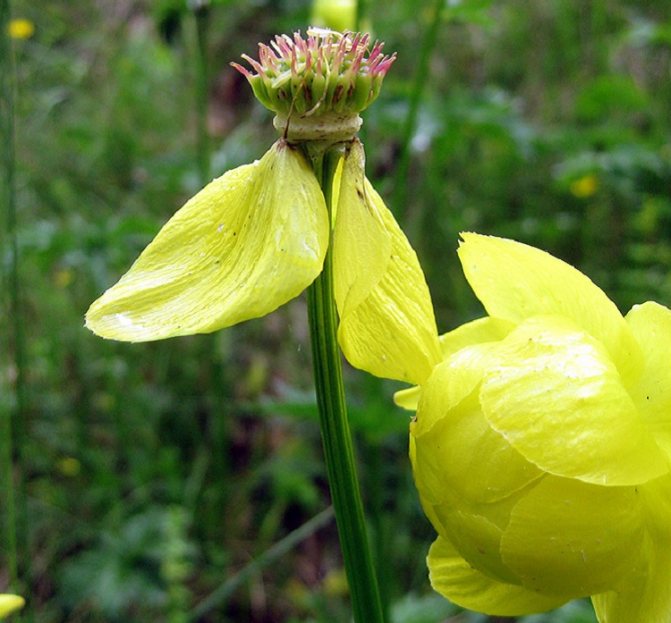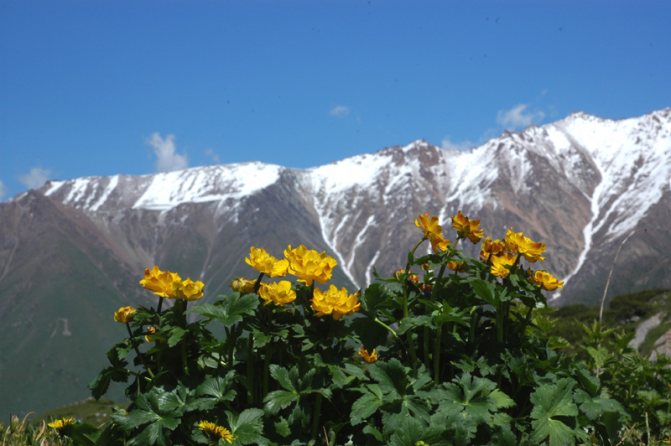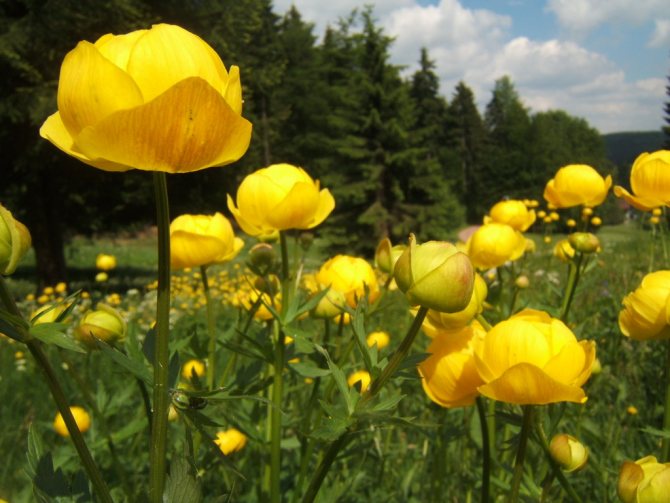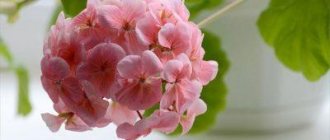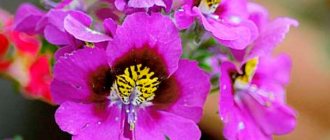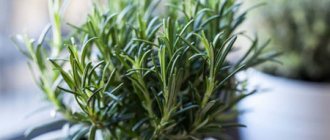The bather is a charming decorative perennial that adorns summer cottages, garden and urban landscapes from the very beginning of summer. It looks great in compositions and flower beds, around artificial ponds and at the foot of alpine hills. In nature, this delicate yellow-orange flower with contrasting greenery grows on mountain slopes, lush meadows, forest edges and damp forest glades, along the banks of water bodies. The plant in different localities is called - frying, lights, Siberian roses, kupavka, avdotka. And although the names are so different, they always reflect the sunny color of the flowers or the preference for habitats - well lit and fairly humid.
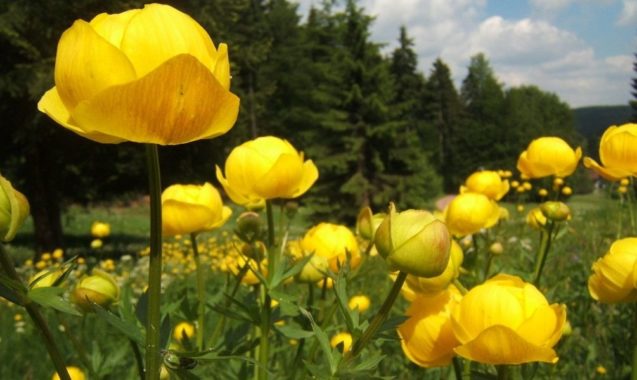
Description of common types
The most famous types are:
European
Differs in its decorative effect. The shape of the flower is in the form of a ball. The color is yellow. Flowering begins from the first days of May... Its duration can reach from three weeks to one month.
Asian
It looks like a European swimsuit. Flowers of this species have a double shape with open sepals.... Flowering is not as long as in the previous species and ranges from 1.5 to two weeks.
Altai
Has a similarity to the Asian species. The main difference between the Altai flower and the Asian one is the color of the flower... Its color is bright orange. In addition, there is a distinctive spot on the inside of the flower. Anthers of brown color also give a special decorative effect to the flower. Abundant flowering occurs at the end of June, and flowering itself begins from the first days of summer.
Chinese
The Chinese swimsuit has an unusual shape of the bush. The bush is high enough. The shape of the flower is flattened, with a bright orange tint... It has a compacted sepal appearance. This species blooms with the arrival of warm July days.
Garden varieties
T. europaeus (K. European)
The flowers are light yellow, about 4 cm in diameter. Bright green palmate-dissected leaves up to 12 cm long consist of 3-5 segments. The height and diameter of the plant is 75x45 cm.
"Superbus"
The variety is distinguished by abundant flowering and a darker shade of yellow flowers.
Among the wild plants that surround us, the exquisite perennial, the bather flower, stands out. Since time immemorial, color lovers have noticed its pristine aesthetic beauty against the background of the lush greenery of nature. As a result, the plant began to be actively used to decorate decorative flower beds, front gardens, alpine hills and city parks.
For the first time, a flower as a decorative culture is mentioned in documents dating back to the 16th century A.D.
Medicinal properties
The bather contains vitamin C. The flower helps to treat liver diseases and also helps relieve swelling... May peel off and swell. To do this, the collected stems must be steamed, and then put in a cloth and applied to the painful area.
An ointment is prepared from the plant that heals abscesses... In ancient times, healers and healers with the help of ointment could treat serious blood diseases and diarrhea.


Despite the information about the toxicity of the Bathing Lady, folk Aesculapius widely use decoctions and ointments from it for edema, boils, tumors, liver and stomach diseases, diarrhea
Swimsuit is used quite often, as it has many useful properties. But, despite these qualities, the plant is considered poisonous. Therefore, you need to know and monitor the dose that the sick person takes. If the dose for the body turned out to be large enough, then this can lead to severe poisoning.... The poisons in the plant can worsen the condition of the brain.
The largest accumulations of poison are in the root system, while in the flower its content is insignificant.
Today it is used less and less often, it is believed that it is poisonous. The bathing suit was used by healers and herbalists to treat various types of scabies, dropsies, and epilepsy.
Some recipes have survived. For example, in order to get rid of a disease such as scurvy, you need to follow the following recipe:
- one teaspoon of flowers
- one glass of water
Stir well, filter and consume 15 to 20 grams three times a day.
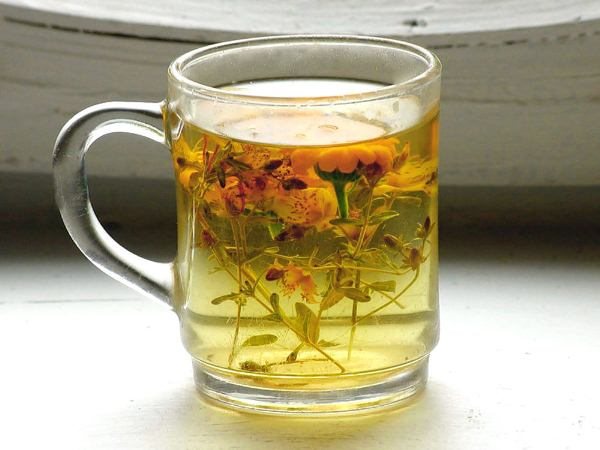

Tincture from Kupalnitsa has found application in the treatment of dropsy, menstrual irregularities, scabies, epilepsy
The root of the plant can be used to get rid of scabies... Pour two tablespoons of dried and ground root with one glass of hot water brought to a boil. Drink this liquid four times a day.
Angina pectoris and edema with heart problems are well treated. Also, the medicinal plant helps against cancer.
Care
With proper plant care, several basic rules must be followed:
- Flowers need to be weeded often and the soil surrounding the bushes must be loosened
... Care should be taken when cultivating the soil and carry out work related to loosening no deeper than 5 centimeters. This is due to the fact that the roots of this plant are close to the surface; - For abundant flowering, you should often water the bushes of the swimsuit
... Especially in open areas; - In the spring, it is necessary to introduce nitrogen fertilization into the soil.
... For the autumn period, superphosphate or ash is suitable; - Regular adding soil rich in useful elements
and, will serve as a reliable prevention of weeds and retain moisture in the soil longer; - After the plant dies off, the leaves and stems are cut
... This time comes in late September or early October; - If the swimsuit in your area is a cold-resistant variety, you should not cover it.
Contraindications for use
If, when applying the infusions, a person has an allergic reaction, then the bathing suit should be neglected.
The plant must be taken seriously, if used incorrectly, it can cause irreparable damage... It can worsen the condition of the human body as a whole and affect certain organs. Decreases metabolism, which leads to a malfunction in the body.
Therefore, a very important component is the use of the exact dosage of the decoction or infusion of the swimsuit. In the worst case, it can lead to death.
How to care for a bush
The bather is a fairly plastic flower culture that does not require special agrotechnical measures. The basic care for the described swimsuit is the same as for other herbaceous garden plants. It includes:
- Top dressing
- Watering
- Pruning
- Weeding
- Preparing for winter
- Reproduction
- Preventive treatment against diseases and harmful insects
Bush care is carried out throughout the growing season, which lasts from early spring to late autumn.
For the development of a healthy plant, it is recommended to systematically pour a nutritious soil mixture under the swimsuit bush. Mineral and organic dressings are also used. Fertilizers are applied to the soil during irrigation or in the form of dry granules.
For this plant it is recommended to use urea or Agricola. The nutrient solution is prepared from 10 liters of pure water and a teaspoon of powder.Fertilization is carried out in early spring, before bud break and before flowering.


Bather in a flower bed
A special place in the care of the Chinese bathing suit is given to watering. Despite the fact that this culture is moisture-loving, it does not tolerate waterlogging of the soil. The soil around the bush should be constantly wet, while water stagnation should not be allowed.
This will lead to the death of the plant. Maintaining proper soil moisture is a major challenge when growing a swimsuit outdoors. But this moment does not reduce its popularity among flower growers.
Experts recommend using a drip irrigation system for watering the bushes and mulching the hole with peat or sawdust.
For secondary flowering, pruning of faded peduncles is mandatory. The bush is completely cut off at the end of October, when the leaves die off. At the same time, petioles are left with a height of 3-5 cm.
The root system of the swimsuit bush is in the upper layer of the soil. Therefore, it is important to keep the area under the bush clean.
All weeds are removed manually, this does not damage multiple roots. Loosening of the soil is also carried out. Its depth varies between 3-5 cm.
Preparations for the winter of the Chinese swimsuit are usually not carried out. This is a hardy plant. But in regions with a harsh climate, you can play it safe and cover the bush with wood shavings or needles with a layer of about 10 cm.
Almost always, the owners of the swimsuit try to breed as many bushes as possible on their site. For flower propagation, you can use seeds and cuttings. But an easier way is to transplant layers. It can be carried out during any growing season. With this reproduction, the plant quickly takes root and begins to bloom in the second year.
While watching the video, you will learn about the swimsuit.
Did the article help? Rate it
The use of a flower in landscape design
The bather is also used for decorative purposes. It is used to decorate the soda area, as well as the area with the rock garden... Flowers with bright orange and bright yellow flowers look very beautiful.
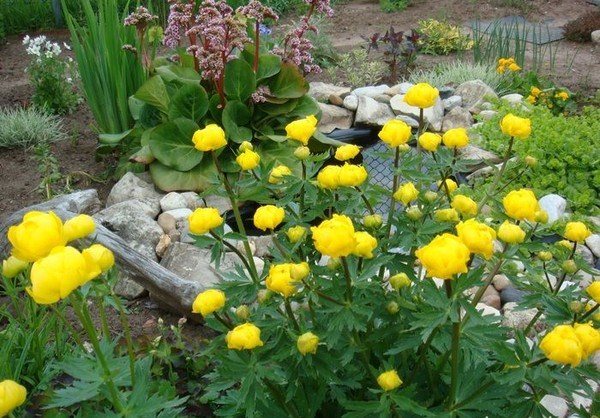

The unpretentiousness of the swimsuit allows you to decorate with it almost any area
Looks very elegant in combination with the blue shades of irises. Mixed landings are created with a swimsuit, and they also look good in single landings and in groups.
The bikini is used to create a decorative effect in the parkx. Flowers look beautiful when decorating the coastlines of reservoirs of various sizes.
Description
The bather is one of the most beloved by most horticultural flower breeders. Often, when decorating a site, a flower is planted in small groups. They perfectly complement the curbs of the front gardens. The garden representative looks especially advantageous near and under the green foliage of trees.
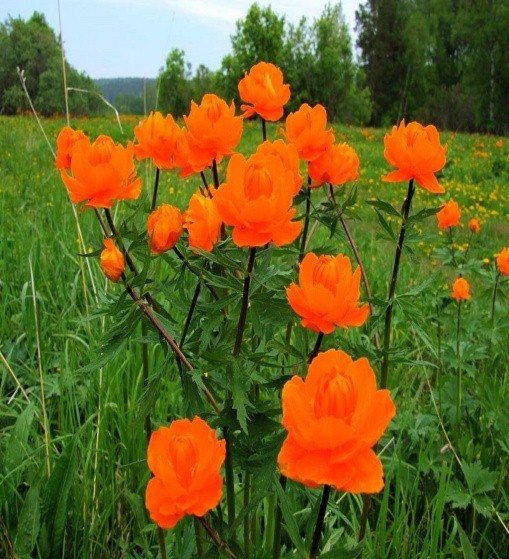

The flower is a perennial and forms a bush. On average, the height of this plant reaches from 25 to 160 centimeters. In the root rosette, erect stems and rich green leaves grow in abundance. By the beginning of flowering, buds appear, forming a spherical shape. Most often, they appear in an amount of 1 to 2 flowers. The average size reaches 5-7 centimeters.
Garden culture has several shades: orange, golden, lemon, yellow
... The flowers exude a unique scent, vaguely reminiscent of the scent of tangerine. In bright light, the petals appear to be glossy.
At the end of flowering, you can harvest the seeds. They are located inside the fruit and are oval in color.
Landing
One of the important aspects in this matter is the choice of a landing site. The best place would be a small shade... The plant loves direct sunlight, but not all the time.For some time he needs to take a break from the sun so that the leaf blades open the stomata and take in more air.
If the plant is not provided with such conditions, then the swimsuit will grow much smaller. And the most important thing is that in this state the flower will not be able to bloom for a long time.
The best places for a swimsuit will be shading under a tree, bushas well as between stones.
A beautiful plant is not too demanding on the quality of the soil. It can be safely planted in unprepared land.
Breeding features
The bather can be diluted with seeds or vegetatively: by dividing the rhizome, cuttings. Although it is not worth disturbing the flower once again, since it does not tolerate transplantation well. A bush can grow in one place for a decade, while its decorativeness increases every year.
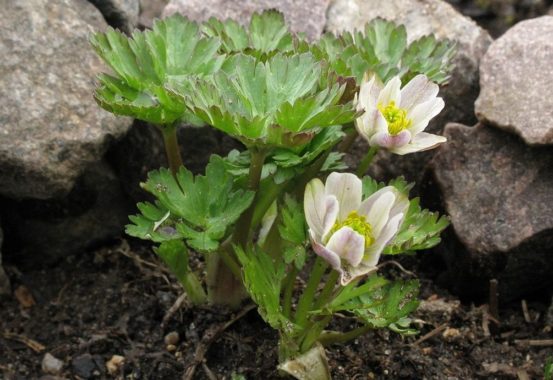

Only adult 5-year-old plants can be divided. The bush is dug out, the old leaves are removed, the rhizome is washed and divided into parts with a sharp instrument, while each should have several buds with shoots. Sections are treated with ash or potassium permanganate solution. The plant sits in a prepared hole with a couple of cm deep at the root collar. When planting, the interval between the bushes should be 40-50 cm.
A bather can also be grown from a cuttings. To do this, squat shoots are cut from the flower at the base, which take root in water or in a peat-sand mixture. Cuttings can be treated with a root stimulant (Kornevin et al.). After rooting, the cuttings are planted in a previously prepared area.
When growing from seeds in the fall, you need to collect the seed. Freshly harvested seeds are sown directly into the ground or into a buried box with a substrate of earth, peat, sand in proportions of 2: 2: 1. Seedlings should appear in May. Seedlings should be protected from direct sunlight and moisture levels should be controlled. When 2 true leaves appear, a pick can be made with a distance of 10 cm between the plants. Flowers are planted in a permanent place in the fall, and preferably next spring. Flowering usually begins from the 2nd year of life.
If sowing is planned in the spring, then the seed requires stratification and is stored for 3-4 months at a temperature of 3-4 ° C.
Basic rules for plant care
The swimsuit plant practically does not require special conditions for its cultivation. Care is necessary as for most plants. Timely watering, the required amount of fertilizing, as well as the destruction of weeds.
With the onset of cold weather, leaf blades die off... Therefore, in order for the plant not to waste energy on this process, the leaves must be cut off and only the petioles left. They will protect dormant buds that will give future flower stalks.
Watering for a swimsuit should be timely and regular. This is especially necessary for young seedlings. In dry and hot summers, the amount of moisture should be increased..
For normal growth and development of flowers, it is necessary to carry out regular weeding from weeds. Loosening of the soil is also an important factor. This procedure must be done carefully, and no closer than ten centimeters to the plants. Loosening depth should not exceed 5 centimeters.
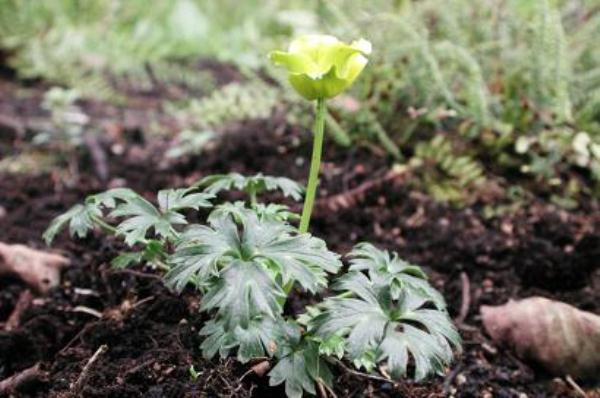

Weeding and loosening of the Swimsuit must be carried out regularly, at a distance of 10 cm from the flowers
Top dressing also affects the plant. The best periods for fertilizing are the first days of May, as well as before the flowering period.
Feeding option:
- ten liters of water
- one tablespoon of urea
- one teaspoon of nitrophosphate
- one teaspoon of Agricola for flowering plants
All the necessary ingredients must be mixed and fed at the right times with a small amount of fertilizer.
The bather is an extraordinary plant that is distinguished by a special color of flowers in bright yellow and bright orange shades.... It is widely used in folk medicine in the treatment of many human diseases. Leotards are also used to obtain an emphasizing decorative effect.
Caring for the plant will not be a hassle, but with proper care, it will give abundant and long flowering.
The bather is a plant of the Buttercup family, which is a perennial shrub. It reaches a height of 50-100 cm, depending on the species. On straight, less often branching stems, 1-2 large flowers grow, having the shape of a ball. The name of the swimsuit in Latin is Tróllius, derived from the German word "Trollblumen", which means "troll flower", so another name for the flower is "trollius".
The plant has a powerful root system, dark green decorative leaves, the shape of which is finger-dissected. Flower petals with a glossy finish, color - golden yellow and orange. Did you know? The flowering of the swimsuit occurs in late May - early June, and its duration is up to one month (all plant species are honey plants). There are about 30 species of swimsuit, two of which are native to North America. Eurasia is the mainland where the swimsuit most often grows. In Russia and the CIS countries, you can find about 20 different types of trollius.
Top dressing: how and what drugs to use?
In order for the swimsuit to bloom magnificently and for a long time, in addition to pruning, the use of fertilizers is required. They are used in small doses. Fertilizers are used that are intended for flowering species.
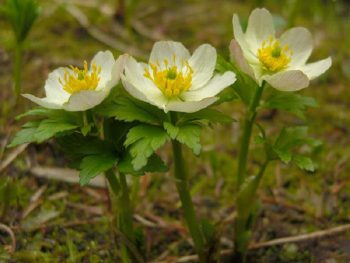

Bathers look very delicate, due to the shape of their flowers, as well as due to the color, thanks to a wide selection of varieties, this ornamental plant can be easily combined with many others.
| Drug name | Release form | Purpose |
| "AVA". Floral and decorative. | The drug is in capsules. It does not dissolve in water, therefore it is introduced into the soil. It dissolves in soil for six months. | For increased disease resistance, lush and vibrant flowering, sustainable growth. |
| Fertika. Flower crystal ". | Water soluble powder. Contains nitrogen-phosphorus-potassium elements and micro-substances. | Restores and strengthens plant immunity, promotes active flowering. |
| "Agricola" reviews about fertilizer Agricola | Available in the form of a liquid concentrate, sticks and granules. | Helps plants to bloom earlier, more abundantly and more luxuriantly. |
| "Etisso" | Liquid concentrate | Promotes the growth and development of plants, the appearance of a large number of buds. |
| "Compo" | Concentrated liquid with a complex of essential substances | Promotes healthy growth, vibrant, lush bloom, disease resistance. |
The swimsuit is fed every 10-14 days before flowering. After the plant stops blooming, it is not recommended to apply fertilizers.
Bather, a description of the culture
The bathing suit plant (Siberian rose, trollius, kupavka) is a flower shrouded in legends. Its name comes from the German trollblume, which translates as "troll flower". Scandinavian beliefs say that these amazingly beautiful flowers were the favorites of forest dwellers - fairy trolls.
According to one legend, the Russian name for the flower appeared due to the love of the bather for wet growing areas. And if you believe the more ancient Slavic legend, the flower owes its name to the patroness of reservoirs - the goddess Agrafena the bathing suit.
The bather is a herbaceous perennial belonging to the Buttercup family. The habitat of its subspecies is vast. The bather can be found throughout the northern hemisphere. It grows in forests, mountain slopes, meadows, along rivers in Europe, Asia and America. In some countries, the swimsuit is already listed in the Red Book.
In the natural environment of growth, the bathing suit has about twenty varieties, but only a few garden forms are grown in culture. The European swimsuit has become very common. For a complete understanding of the features of this culture, consider what are the features of the external structure of the European swimsuit:
- The swimsuit owes its showiness to flowers. They are moderately large (up to 8 cm in diameter), bright yellow or juicy orange. As with other members of the Buttercup family, the intensity of the color is concentrated on the sepals, not the petals.
- The rim of the swimsuit is formed from 5-20 petal sepals. They overlap each other strongly, arranged in a spiral. After flowering, the sepals fall off.
- The shape of the flower is spherical, it can be half-open or completely open. Inside the bud, there are thin linear petals that have been transformed into nectaries.
- The fruit of the swimsuit is a spherical compound fruit, consisting of leaflets tightly overlapping each other. The seeds are very small, their color is black, the surface is glossy.
- Leotards of the swimsuit are palmate, herbal color. Leaves come from the root zone. On a flower shoot, foliage is placed only in the upper part, which turns into a flower.
- During the flowering period, the bather spreads a light, subtle scent of freshness.
- An important feature of the swimsuit is its toxicity. Its juice can cause burns on the skin and mucous membranes, so all planting work must be carried out with gloves.
Leotard care after landing
Young plants are shaded and watered regularly. They dive in the presence of a second true leaf, leaving 8-10 cm between seedlings. They are transplanted to a permanent place in the spring of next year.
Some (European, Dzungarian, Ledebura) bloom the next year after planting, but at first they give only one peduncle with a single flower. In the future, as the curtain grows, the number of peduncles and the number of flowers on one shoot increases. With good care, a European swimsuit can form up to 10-20 buds on a bush, and up to 40 buds at a time.
Perennial herbaceous plants with deeply dissected leaves and large, showy flowers from light cream to bright orange color, blooming in late spring or early summer. The diameter of the flowers of most species is approximately 5 cm.
Bathers quickly form small clumps. They are unpretentious and grow well on wet soils of any type. The best place to grow them is on the banks of a garden pond or stream. Bathers also look spectacular in mixborders if they are regularly watered and mulched in dry weather. Small species such as Trollius acaulis (Stemless bathing girl) and G. pumilus (K. dwarf) are great for rock gardens and swamp gardens. Homeland - temperate regions of Europe, Asia and North America.
G. acaulis (K. stemless)
A small compact species with bright yellow flowers that bloom in early summer. Leaves about 5 cm wide, collected in a basal rosette, sit on short petioles. The height and diameter of the plant is 25x25 cm.
G. chinensis (syn. T. ledebourii) (K. Chinese, K. Ledebour)
Orange-yellow flowers bloom on tall stems in early to mid-summer. The leaves reach a length of 12 cm.The height and diameter of the plant is 75x45 cm.
What are the best species of swimwear to plant in the garden?
Of course, species swimsuits are the most common in our gardens. "European" (T. europaeus) and "Asian" (Trollius asiatlcus) swimsuits bloom almost simultaneously - at the end of May, "Chinese" (T. chinensis) and "Ledebura" (T. ledebourii) - in the second half of June. These are the brightest of the species swimsuits! Their flowers are orange-red, shiny, large, 5-6 cm in diameter, because of the numerous nectary petals, they seem almost double. The total flowering period lasts over two months.The height of plants in these species is different, but on average from 70 to 100 cm. The flowers of the "Chinese" swimsuit of an unusual shape, wide open, bright orange. Long petals-nectaries, located in the center, rise above the flower, in the form of sharp feathers, like the Mohawk of the Indians. A similar flower structure has a variety "Etna" (‘Etna’). The Chinese bathing suit "Ledebour" is very similar to the one.
But from the undersized there is only one species - the "Dwarf" bathing suit (T. pumilus), the height of the plant varies from 15 to 25 cm. The flowers are wide, flat, similar to a large buttercup - up to 3 cm in diameter.
Varieties and varieties of the swimsuit
The genus of this plant has its own biological characteristics.
Now in Russia and in the neighboring countries, nineteen species and seven varieties of swimsuits are grown. These include: a European swimsuit, the highest swimsuit, a semi-open swimsuit, an Asian swimsuit, an Altai swimsuit, and a Dzungarian swimsuit.
And also a purple bikini, a stemless bikini, a dwarf bikini, a Chinese bikini, a large-petal bikini, Ledebour’s bikini, Rieder’s bikini, a beautiful bikini, etc.
See the varieties of the swimsuit in the photo here:
Choosing a decent variety!
Most of the garden forms and varieties are united under the name of the "Kulturnaya" bathing suit (T. x cultorum). As usual, unlike natural plants, varietal plants have larger flowers, often double, of various colors - from pale yellow to bright orange-red.
Bather "Elist of All" (Earliest of AH) - the earliest, blooms in early May, abundant flowering, low plant, medium-sized flowers, sepals are dark yellow, nectaries are light yellow. "Gol Cross" (Orange Crest) - yellow sepals, and orange nectaries, medium-sized flowers, low plants. It also blooms profusely from mid-May to early June.
The European swimsuit (T. europaeus), the most common in our gardens, blooms at the end of May. The Golden Queen blooms last, from the end of June to the end of July.
There are varieties with bright orange flowers: Orange Glow, Orange King, Orange Prinzess, Goliath, Fire Globe , Prichard Giant, Etna.
Varieties with yellow or lemon yellow: Lemon Queen, Earliest of All, Canary Bird, Superbus.
And only two varieties, with unusual light cream flowers with lemon stamens: Alabaster and Cheddar. In the first, the flowers are spherical, in the second, they are more open with a slight greenish tint. Plants are short, with dark green leaves. The most suitable conditions for them are full sunlight with sufficient moisture. Alabaster repeats flowering at the end of summer.
Popular types of the favorite flower of the trolls
Currently, there are about 30 varieties of this cute flower, 20 of them grow on the territory of Russia.
European swimsuit
The plant is found in Siberian forests near water bodies or on wet lowlands of rivers. Her buds resemble miniature bells. At the beginning of flowering, they look like small lemon balls composed of glossy sepals. Later, they open up in all their glory and attract many insects that fly in search of sweet nectar. The base of the plant is decorated with finger-dissected leaves on long petioles.
Chinese bathing suit
The peculiarity of the flower is its large size. It grows up to 120 cm in height and is distinguished by expanded buds of a wide-oval shape. The most famous variety of this species is the Golden Queen swimsuit. Its height is about 80 cm. Finger-shaped leaf plates are collected at the base of the plant and remain decorative throughout the season. Golden buds bloom in June and have an unusual shape.
The plant grows successfully in open areas where there is a lot of sunlight. Loves moisture, but disappears with prolonged stagnation of water. It tolerates winter cold wonderfully and does not need shelter.
The Golden Queen swimsuit shown in the photo is distinguished by delicate petals, bright color and unique shape of the buds.It is widely used to decorate artificial ponds, curbs, rocky gardens and mixborders.
Dzungarian bathing suit
This type of flower belongs to low dwarf varieties, reaching a height of only 15 cm. But if the soil is fed with humus, the bather can conquer a half-meter height. In its natural environment, it is found in the mountains and in open areas of mixed forests. It blooms in early summer and lasts a whole month. The buds are colored bright yellow.
Swimsuit outdoor landing
The easiest way to get a swimsuit on your site is to buy ready-made seedlings and plant them in a flower bed. You will not need special skills to grow it, but it is important to remember one feature of this culture: trollius grows only in wet soil and if planted in dry soil, it will die.
Choosing a place for planting a swimsuit and preparing the soil
When choosing a place for landing, pay attention to the area with diffused light. It can be a cozy place under tall ornamental bushes or a rocky hill. The main thing is that the bright sun does not shine on the swimsuit for a long time.
You can plant a swimsuit in an open flower bed, but you must be prepared for the fact that its flowering will be short-lived, and the flowers will be faded and small in size.
The swimsuit has no requirements for the composition of the soil, so there is no need for serious preparations before planting. But a medium loamy soil will have a good effect on the development of a flower. It is also desirable that there is no stagnation of water in the selected area.
If you still want to create the best conditions for the trollius, you can add a little mixture of peat with humus and 10 g of nitrophoska to the planting hole. And if the plant is planted in a sand mixture, it is advisable to add moss as well, which will ensure the preservation of moisture.
Did you know? The bather is not adapted to both dry and sandy, and damp and swampy areas. In them, she will not be able to develop and will soon die.
Planting a swimsuit on a flower bed
The swimsuit should be planted in August. Although all its varieties are frost-resistant, young plants should get stronger and grow rhizomes before winter comes. If you plant the trollius later, then he will certainly die with the arrival of the first frost.
All varieties of the swimsuit quickly take the form of a densely branched bush, so you need to plant the plants at a distance of 50 cm between each other. It is necessary to deepen the root collar of the plant by 2 cm. The leaves are immediately trimmed so that rooting is successful. New foliage blooms within two weeks after planting.
Advice! The bather can grow in one place for a long time, so the plant can be transplanted every ten years.
Secrets of growing a troll flower at home
So that a wonderful piece of the sun appears on the site, you can use traditional options: dividing a bush, buying seedlings in a store and sowing seeds in a bathing suit. The latter method is used for growing plants, both in open ground and in containers.
Since flower seeds have uneven germination, it is best to grow seedlings indoors first. When it gets stronger, transfer it to open ground.
Growing from the seeds of a swimsuit - an exotic troll flower, begins with the preparation of the soil. It must meet the following requirements:
- looseness;
- breathability;
- nutritional value.
It is obtained by mixing, leafy soil and humus in equal parts. To know how to grow a swimsuit from seeds, you should familiarize yourself with the basic rules of this process.
Sowing is started in winter, best of all in January, in order to prepare seedlings in a timely manner. First, the prepared soil is laid out in containers, after which shallow holes are made at a distance of 35-40 cm. Then the containers are placed in a room where the temperature does not exceed + 4 ° C for 3 months.
Growing a swimsuit and caring for a plant involves regular watering.It is carried out as the topsoil dries quickly. When sprouts appear, a dive is carried out, leaving the best specimens. At the end of summer, young flowers are planted in open ground in a suitable area of the garden.
If it is not possible to grow seedlings, the seeds of the swimsuit can be sown in the fall directly into the open ground.
Swimsuit grooming in the garden
The trollius needs to be watered all the time, fertilize periodically and cut off dried shoots. If you adhere to these basic rules, the plant will grow rapidly and will even delight you with double flowering per season.
Frequent loosening of the soil is also carried out to a depth of 2-4 cm, but not deeper, so as not to damage the fragile root system.
On a note! The bather is a frost-resistant culture, so there is no need to build a shelter for the winter.
Watering and weeding the swimsuit
The plant needs to be watered often, but no frills: the swimsuit should be in moist soil without stagnant water. Any deviations towards underfilling or waterlogging will negatively affect the growth and flowering of the crop. This moment is especially important in caring for young bushes.
Removing weeds is a must when looking after a swimsuit. To conserve strength, you can mulch the bush. This will maintain moisture near the roots and prevent weeds from drowning out the plant. But if the mulch does not fit into the landscape design, you can do without it.
A wise approach to caring for the "favorite" of the trolls
Although the plant does not require special attention to itself, this does not mean that it does not need to be taken care of. In fact, planting and caring for a swimsuit is considered a pleasurable experience for flower growers. It includes 4 main procedures:
- moisturizing;
- weeding;
- top dressing;
It is important to carry out plants in a timely manner so that the swimsuit does not suffer from "thirst". Once the soil is dry, it's time to give it a fresh dose of moisture. In dry times, the procedure is repeated almost every day.
You can feed the flower with peat or special fertilizers. It is best to do this in early May and just before the ejection of the buds. Gardeners recommend preparing a solution from the following components:
- clean water (10 l);
- urea (1 tablespoon);
- nitrophoska (1 teaspoon).
Top dressing is done in small doses at the appointed time.
To rid the plant of its neighbors, weeds, it should be weeded periodically. As a result, the flower will not lose its decorative appearance throughout the season. If there are no weeds in the flower bed, loosening of the soil should be done. This procedure has a beneficial effect on the development of the swimsuit. After a while, the summer cottage will turn into a kingdom of exquisite fiery flowers.
Growing a swimsuit - video
There are a lot of names for this type of flower: light, hot color, Siberian rose
... Scientists gave their name to this beautiful plant - the bather.
Currently, there are several hypotheses about the appearance of the scientific name of the plant. The first version is rather unusual. The German word trollblume, translated into Russian, means "flower of trolls". Based on one ancient legend, many assume that the bather was the most beloved plant of the fairytale heroes of the trolls.
The second version is based on the assumption that the culture originated from lat. trulleus. The exact translation will be the word - bowl, which accurately characterizes the shape of a rounded flower.
Based on the Russian version, the swimsuit got its name in connection with the numerous flowering of the plant that falls on the Slavic traditional holiday, Ivana Kupala. The simplest explanation for the name of this culture can be considered the fact that the plant is most often located on wet areas of the earth (streams, rivers) and blooms profusely with the opening of the bathing season.
The title photo shows the purple bather (Trollius lilacinus).
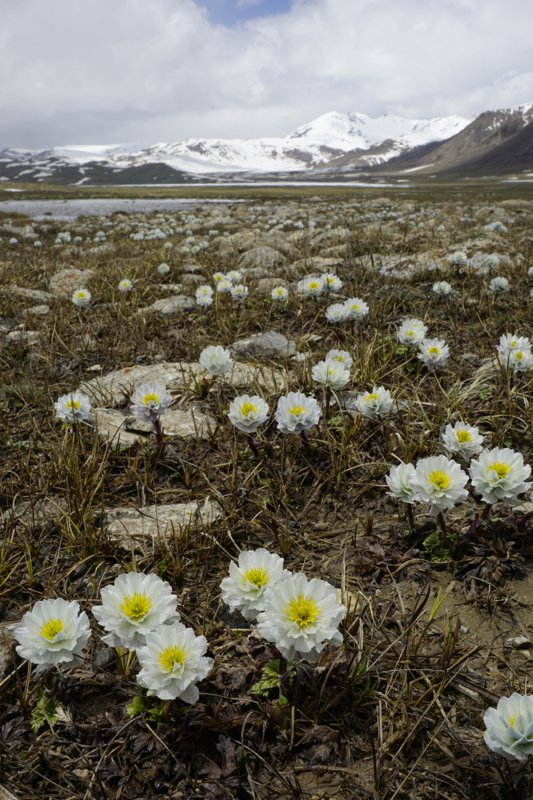

Pest and disease control
Bathers, due to their vitality, are rarely susceptible to any kind of disease.
However, for their better condition, early spring ash treatment is recommended, with spring growth - fertilizing with nitrogen fertilizers, and in the future, complex fertilizers should be used.
At the very beginning of flowering, it is advisable to spray the swimsuit with epin in the amount of ten drops per 1 liter of water.
For the prevention of fungal diseases, you can remove old dead leaves in the fall.
Rarely, a swimsuit can be affected by septoria, smut, penetrating short-bodied nematode.
How to grow a garden crop from seeds
For abundant flowering in summer, you need to take care of planting seeds. from late summer or early autumn
... This issue should be dealt with immediately after collecting the seeds. If you plant stale seeds, then the percentage of germination will decrease significantly.
The first shoots appear in spring. The plant breaks out of the ground very slowly. The number of sprouts is not very numerous. You should immediately start watering the plant, and wait for the first green leaves to appear. In May, seedlings begin to dive at a distance of 5 to 10 centimeters from each other.
For some varieties of horticultural crops, for example, a Chinese swimsuit, sowing possible in early spring
... She will delight with her flowering by the end of May. Planting with seeds is one of the common plant breeding methods.
Trollius pumilus
Place in landscape design
Growing a swimsuit is very popular for decorating garden and summer cottages. Most often, the European swimsuit (ordinary) is bred, although other varieties are no less decorative.
The neighborhood looks gorgeous with flowers such as delphinium, cornflower, catchment, when yellow is combined with purple and lilac. For the foreground, stunted plants are suitable - badan, clover, sleep-grass, oxalis.
A garden slide with a stone is well suited for the decoration of the site, where the swimsuit occupies the middle space, ground cover perennials are located in front of it, and tall ones (cornflower, bell) are located behind it. At the same time, take into account the timing of flowering, so that during the whole summer period on your hill, some flowers replace others.
Landing conditions and scheme
It is easy to care for this crop if it is planted in the most appropriate conditions. For a permanent place of growth, it is advisable to choose a site on the south side.
Free access to sunlight and daylight allows the bush to develop evenly and bloom quickly. The Chinese bather also grows well in shaded places, but with such a planting, the stems of the bush can be sharply extended, and the number of flowers is much less.
The soil should be light and loose with good water permeability and aeration. Almost all types of soil are suitable for growing this culture, except for dry sandy loam. When selecting a site, it is necessary to take into account the fact that the nutritional composition of the soil also affects the development of the flower.
Read also: 2019 is the year of which animal of the yellow earth pig
Therefore, if the soil is not fertile enough, constant artificial enrichment with complex dressings will be required. The acidity of the soil is neutral or alkaline.
Do not allow waterlogging or stagnation of water under the bush. Therefore, it is recommended to plant a swimsuit in an area where the groundwater level is not closer than one meter or to form raised flower beds.
If several bushes are planted, the following distances should be observed: 0.5 m between bushes, 0.7 m between rows.When planting near a transparent fence, they retreat 0.6 m from it.
If the fence is closed, the bushes are planted at a distance of 0.8 m from it. Such a planting scheme not only allows the plant to develop freely and take its natural form, but also facilitates access to each bush when leaving.
If the place for the swimsuit is selected in accordance with all the recommendations, the plant can develop on it for 10 years.At the same time, over time, the appearance of the aboveground part, the density of the bush, the period and splendor of flowering do not change.
Application in traditional medicine
Although kupavka is a rather poisonous plant, its medicinal properties help in the fight against many diseases. The European bathing suit (ordinary) is especially popular in folk medicine. Its flowers, roots and leaves are used to prepare infusions and decoctions that act as anti-inflammatory and healing agents. The herb of a medicinal plant has long been helping to heal tumors.
Tincture of flowers is used to treat dropsy and scurvy, and tincture of roots is used for scabies. If the leaves are insisted, such a remedy will help get rid of angina pectoris.
Planting a swimsuit and choosing a suitable place
It is better to choose a landing site in partial shade, but with regular watering, swimsuits develop well in illuminated areas. Plants are durable, they grow in one place for 10 years or more, therefore, before planting, the soil is carefully cultivated, removing the rhizomes of perennial weeds. To improve the structure of the soil, the planting holes are filled with a mixture of soil and peat or compost. The optimal distance between the bushes is 40-45 cm.
By choosing the right place and the right fit for the swimsuit, growing and caring for it is quite simple.
Plants are weeded regularly, they are not loosened deeply, at a distance of less than 10 cm from the trunks - no deeper than 3-5 cm, given that most of the surface roots are located below, which can be easily damaged.
Most species are regularly watered until fall in dry weather. For better development, nitrogen is added in the spring, and fertilized with superphosphate and ash in the fall. A good effect is provided by the constant pouring of soil rich in humus to the base of the stems. An important element of care is mulching, which helps prevent weeds and retain soil moisture.
The aboveground part of the bather dies off in September-October, only after that the leaves and stems are cut off. Earlier pruning weakens the regeneration buds, which will develop into flowering shoots the next year.
All types of cold-resistant, can winter without shelter.
Title [edit | edit code]
The origin of the scientific name of the genus is not exactly known. Perhaps the Latin name comes from him. Trollblume, which can be translated as "Flower of the trolls". According to Germanic and Scandinavian legends, this plant was considered the favorite flower of the trolls. According to other versions, due to the rounded and even spherical shape of the flower, the name was formed either from the Latin word trulleus
meaning "round vessel", "cup"; or the Old Germanic word "
troll
"-" ball ".
The Russian name of the genus is associated with the plant's tendency to wet habitats.
In many regions of Russia, various popular names are adopted, which denote a species or a group of species characteristic of the area: kupava, kupavnitsa, kupavka, kolupalenki, frying, lights, Siberian rose, avdotki, bells, mallets, koltysh, coachman's grass, balabolki.
General characteristics of the plant
- This type of culture belongs to the buttercup family;
- The homeland of the flower is: Asia, Europe and North America;
- The plant has a short rhizome and a straight stem;
- The shape of the leaves is often lobed;
- Leaflets have a ball-shaped fruit;
- The swimsuit propagates by means of cuttings, dividing and seeds;
- In preferences for lighting the area where the flower grows, you should stop on the floor of a shady area;
- The culture prefers abundant watering and is winter-hardy;
- The bather blooms from late spring to the beginning of the summer season.
Botanical description [edit | edit code]
Leaves are palmate or lobed. The flowering shoot most often has a two-year development cycle. In the first year, a root rosette of leaves develops. The next year, the apical growth continues.A shoot is formed, leafy only in the upper third of the shoot and ending in a flower. The lower leaves of the peduncle are larger, often petiolate, and the upper leaves are sessile. Often, lateral shoots develop in the axils of these leaves, each of which ends with a flower. The size of such flowers decreases towards the top of the main shoot.
In the structure of the flowers of swimsuits of different species, there is much in common, despite the differences in the color of the flowers. The commonness of flower forms is especially characteristic - from spherical to half-open and open. The flower consists of a corolla perianth with five or more (up to 20) petal-shaped, brightly colored yellow or orange sepals that fall off after flowering. Sometimes there are swimsuits that are transitional in color and shape: from green to yellow and orange, with a jagged edge, like that of the apical stem leaves. All parts of the swimsuit flower are arranged in a spiral. Corolla petals are modified into nectaries. They are numerous and, in comparison with the petal sepals, are shorter, equal to or longer than them. This serves as a feature that distinguishes one species from another. The nectars are narrow, linear or widened in shape. At their base there is a honey pit - a nectary. There are numerous stamens and pistils sitting on a convex receptacle. The flowers have a faint pleasant smell. In flowers of many species of the genus of swimsuits, the inner cavity is closed, with the exception of a small hole at the top. Thanks to this arch, the pollen is well protected from damage by dew and rain.
The fruit is a leaflet with a spout that opens along the inner seam. Leaflets are collected in a spherical compound fruit. Seeds are black, shiny, oval.
Breeding methods: dividing the bush
Trollius can be propagated in several ways: by seeds, by dividing a bush, or by purchasing ready-made seedlings in a specialized store. If the purchase of seedlings is not suitable for some reason, or if you want to propagate an existing bush, it remains to use seeds or root division.
It is necessary to propagate the swimsuit by division in the summer, after it has faded. At this time, the plant has a dormant period, so the roots take root more easily.
This is done like this:
- Prepare new holes. Dig up the soil well and water. It is imperative to do this in advance, so that you can immediately plant the cuttings, otherwise their roots will dry out and instead of new plants, an existing flower can be destroyed.
- Using a sharp knife, dig out the bush.
- Divide it into several divisions so that at least 3 buds remain on each - then next year about 6 peduncles will form on each new bush.
- Without shaking off or cleaning the soil from the roots, immerse them in prepared places and sprinkle them with earth. The soil is not compacted, but it is well watered - the moist earth will settle down by itself, and the root system will be subject to minimal impact.


The photo shows the flower stalks of a lilac swimsuit, which are distinguished by a delicate color color, as well as an amazing shape.
Application [edit | edit code]


The spherical flowers of the plant, yellow or orange in color, are very decorative, which is the reason for the massive collection of wild flowers in early summer.
The plant has long been, but to a limited extent, introduced into the culture as an ornamental. European bathers began to be cultivated in gardens from the end of the 16th century. In the middle of the 18th century, the seeds of the Asian swimsuit ( Trollius asiaticus
) to Europe for Karl Linnaeus was sent by the scientist and traveler Eric Laxman, who lived and worked at that time in Siberia. As decorative, several large-flowered species are mainly used: European swimsuit (
Trollius europaeus
), Asian swimsuit (
Trollius asiaticus
), Chinese swimsuit (
Trollius chinensis
), Altai swimsuit (
Trollius altaicus
), Ledebour's swimsuit (
Trollius ledebourii
), on the basis of which (especially the first three) many garden varieties and forms have been derived, usually combined into a hybrid cultural swimsuit (
Trollius × cultorum
). Most of the modern decorative types and forms of swimsuits have been present in European gardens since the 19th century. An introduction to the culture of the purple swimsuit (
Trollius lilacinus
) is of great importance for the purpose of breeding new varieties of swimsuits of cold tones (blue, purple), resistant to low temperatures. Bathers are strong and viable plants and are practically not damaged by diseases. For a better condition of the plants, early spring ash treatment is recommended, fertilizing with nitrogen fertilizers during spring growth, and in the future, complex fertilizers should be used. At the beginning of flowering, it is advisable to sprinkle the plants with epin. In order to prevent fungal diseases, it is recommended to remove old dead leaves in the fall. In rare cases, a swimsuit can be affected by smut, septoria [4], and the penetrating short-bodied nematode (German Pratylenchus penetrans).
In some sources, more often in oriental medicine, certain species are considered as medicinal plants, but it must be borne in mind that the roots of all types of bathing suit are poisonous. In the folk medicine of Western Siberia, Altai, Mongolia and in Tibetan medicine, the Asian bathing suit (Trollius asiaticus
) and the Altai swimsuit (
Trollius altaicus
).
All types of swimwear are known as honey plants. Bathers are well eaten by livestock [5].
There is evidence that the bathing suit was previously considered as a dyeing plant. The flowers of the Asian swimsuit in the 19th century were used to prepare yellow textile paint. In the middle of the 20th century, the Botanical Institute of the Academy of Sciences of the USSR proposed methods for obtaining an Asian yellow dye for edible fats from the flowers of a swimsuit.
Species diversity with photo
The first information about the flower swimsuit as a decorative culture was registered in the 16th century. The seeds of the plant were sent to Europe by the scientist E. Laxman especially for K. Linnaeus.
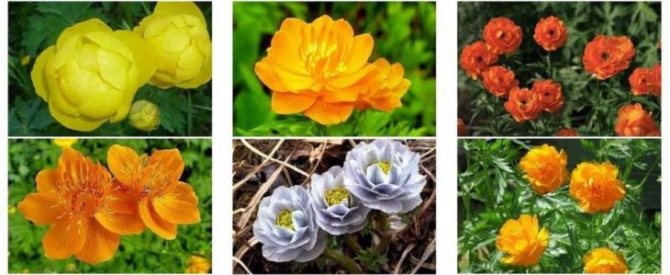

Modern decorative varieties used in Russian horticulture are derived from the following species:
- European or common - native to Europe and Western Siberia. Golden flowers, up to 5 cm in diameter, have a spherical shape, so this type of swimsuit is also called "bells". At first, the flower is tightly closed, and over time, the sepals begin to open, while a dense bunch of nectary petals appears from the center. The height of the plant depends on the habitat from 20 cm to 1 m. This species is of economic importance and is valued as an early honey plant.
- Asian or Asian light - this type of swimsuit is distinguished by the half-closed shape of a large beautiful flower. They are often referred to as "roasts" or "lights". The color can vary from pale yellow to bright orange. The height of the species is from 40 to 70 cm. In nature, it grows in Siberia, Altai, and Mongolia. It is used in folk medicine, and was previously used for the preparation of dyes.
- Chinese is a tall species (1-1.2 m) originally from China. Large flowers are expanded rich orange color. The plant starts flowering at the end of June.
- Altai has large, globular orange buds that are reddish on the outside with narrow petals and black pistils. Height about 1 m. Occurs in Altai, Siberia, Asia.
- Ledebour is a tall plant with large flowers of all shades of red.
- Lilac or blue light is used to breed varieties with flowers of lilac, blue, blue tones. In nature, it grows high in the mountains near snowfields, in swampy tundra. This short plant with single small flowers begins to bloom in the middle of summer. Found in China, Asia, Altai.
Gardeners mainly grow hybrid varieties, united by the type of cultural or hybrid swimsuit.
The mass picking of flowers for bouquets or transferring to private household plots leads to a decrease in the population, therefore the bikini is listed in the Red Book in many countries and regions.
Swimsuit, photo in nature
Flower swimsuit: general information


The plant is a charming perennial with yellow-orange buds. It adorns urban landscapes, gardens and summer cottages with the onset of summer. It is successfully used for flower arrangements that are grown next to artificial reservoirs. In the natural environment, the swimsuit flower occurs:
- on hills and mountain slopes;
- near streams of water;
- on forest edges;
- off the shores of lakes;
- on lush lawns.
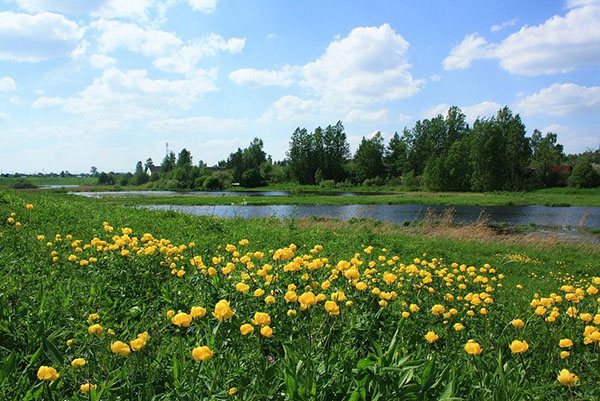

The distribution area is the temperate latitudes of the Northern Hemisphere, the Mediterranean and the Far East. The Latin name of the flower "Trollius" is associated with the legends of the ancient Scandinavian peoples, who believed that the plant was considered the favorite plant of the trolls. On the territory of Russia, it is called differently. Here are some options:
- lights;
- Siberian roses;
- frying;
- troll flower;
- avdotki;
- kupavka.
Despite this, each of the names reflects a specific feature of the plant, be it coloring or habitat.
The Russian name of the flower is timed to the pagan holiday of Agafena the Bather, which was celebrated on July 6. Since that time, the swimming season began in the nearby rivers and lakes.
The flower swimsuit belongs to the Buttercup family. Depending on the species, the plant can grow up to 100 cm in height.
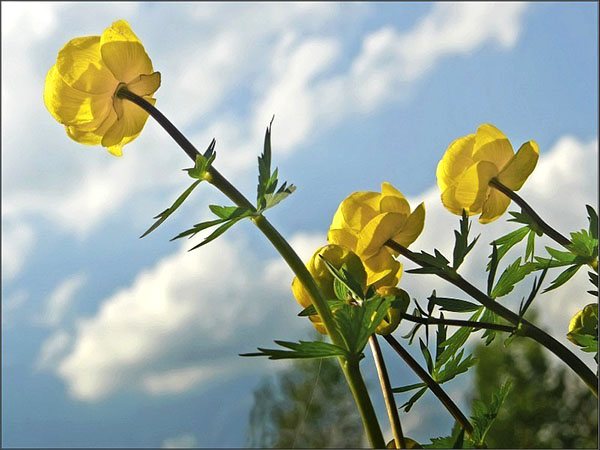

Shoots are most often straight, which have many branches. During the flowering period, the swimsuit dresses in spherical buds of bright colors, located on long peduncles. In addition, the plant is characterized by the following features:
- strong root system;
- leaves are dark green;
- the shape of the plates is loop-cut;
- the petals are characterized by a glossy finish.
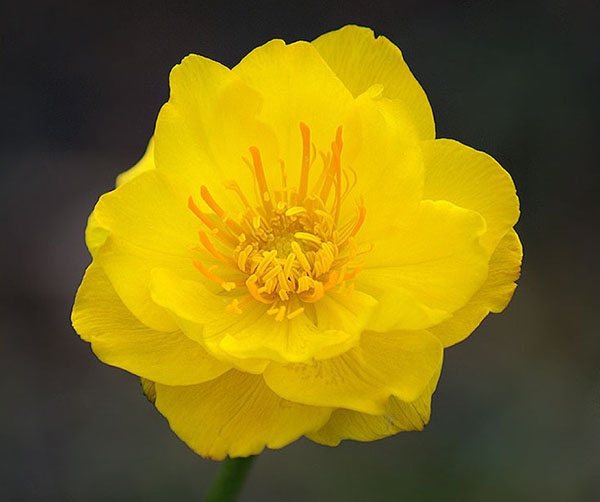

Despite the fact that all types of swimwear are considered poisonous, insects love them for their large amount of sweet nectar. At one time, the flower was massively used to create bouquets, so its number in nature has significantly decreased. In order to preserve the unique plant, in many countries it is included in the Red Book.
Distribution in nature and features of cultivation as a cultivated plant
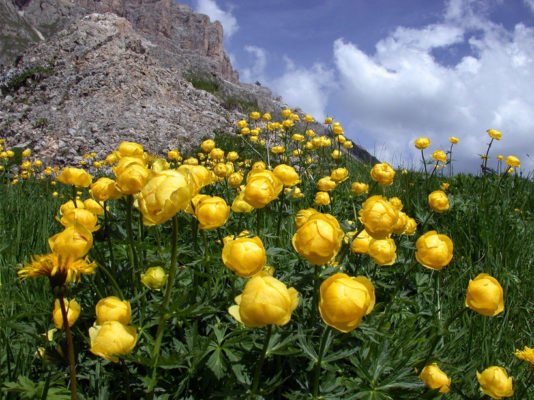

In nature, the flower is found in places where there is enough moisture.
Also known as kupavka, Siberian rose, roast and trollius. Scandinavian legends say that this plant, because of its beauty, was popular with fabulous forest dwellers - trolls. The Slavs loved it no less and called it "kupavka" because it is most often found near ponds and rivers.
There is a legend that the plant appeared thanks to
European or Asian? Differences in the photo
The bather is found near water bodies, at the edge of forests, in meadows and in forest glades. In nature, there are more than 20 varieties of it, however, varieties of only a few of them are used as garden plants. The most common are European and Asian. They can be distinguished by the color of the flowers and the degree of disclosure of the sepals. The European flowers are lemon yellow, while the Asian ones have orange double flowers. Sepals of the Asian species are more open.
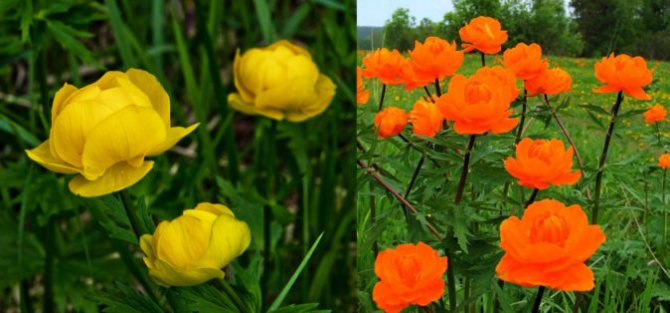

European view (left) and Asian view (right)
The halo of distribution of the plant covers Central Asia, Eastern Europe, the Polar Urals and Western Siberia. Thus, it easily adapts to almost any climate and endures cold winters.
On the territory of a suburban or suburban area, it can be located near an artificial reservoir, on an alpine slide, a flower bed or in a rose garden (since one of its alternative names is "Siberian rose").
Read also: Pennisetum: growing, planting and caring for cereals in the open field
The flowering period is at the end of May. It lasts from 1 to 2 months.
Leotard flower omens. The magic of the swimsuit
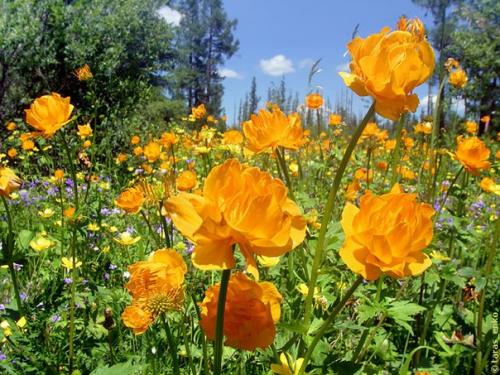

In Russia, this flower is called Fry or Yarila's grass, in Germany - the Troll's Flower. In Germany, there is a legend about him that once the trolls lost a bag of gold somewhere. They looked for it, looked for it and did not find it - and so that people would not get it, they turned gold into flowers.The gold was scattered, so flowers grew here and there. The flower was called the bather, because the time of its flowering was determined by the moment when you can already swim in rivers and lakes, the water warms up. By the way, mermaids were also called "kupavka". In Russia, it was believed that the sun god Yarilo gave his roses to mermaids - the heat of his heart. As soon as kupavki bloom, mermaids run through the forest and lead round dances, swing on tree branches and weave wreaths from the gift of God. The legend about the Bathing Lady, which came from Western Siberia: “A slender young shepherd Alexei often drove herds of horses to a watering hole in Lake Baikal. The horses flew with acceleration into the bright waters of the lake, raising fountains of spray, but Alexei was the most restless of all. He dived and swam so happily and laughed so contagiously that he scared all the mermaids. The mermaids began to invent various tricks to lure Alexei, but none of them received his attention. Sighing sadly, the mermaids sank to the bottom of the lake, but one of them fell in love with Alexei so much that she did not want to part with him. She began to get out of the water and quietly chase the shepherd. Her hair was sunburned and golden. The cold gaze lit up. However, Alexey did not notice anything. Sometimes he paid attention to the extraordinary outlines of the fog, similar to a girl holding out her hands to him. But even then he only laughed and accelerated the horse so that the mermaid jumped aside in fear. The last time she sat near Alexei by the night fire, trying to draw attention to herself with a whisper, a sad song and a pale smile, but when Alexei got up to approach her, the mermaid melted in the morning rays, turning into a flower of the Bathing Lady, which Siberians affectionately call Zharki . " Often the flower was used for love spells and to enhance sexual desire. Flowers were laid over the object's things, or they washed his linen with these flowers, put it under the mattress. It is believed that a swimsuit increases the strength and effect of a love spell, therefore things are still fumigated for her. They also used flower heads, sprinkling them on a bed - a bed or paved the shelves in a bath (this is if they sleep or wash together). You can throw the heads of the flowers into the bathtub and climb there together with half - it raises male strength and attraction, as well as female sexuality. The bathhouse was especially actively covered with the bath on Midsummer's night. In some provinces, it was customary to make bouquets of flowers for Agrafena Kupalnitsa and Ivan Kupala in order to ward off evil spirits. On the day of Agrafena, it was customary to use a bather to divine death. For each member of the family, they picked a plant, stuck it into the walls of the house and watched: whose flower withers faster, it will hurt and die. Terrible fortune-telling. Fortunately, rarely performed. By this flower, they also wondered whether this or that guy loves or dislikes. In the astrological herbalist, the flowers of the Bathing Lady are referred to as people born under the constellation Pisces. The bathers showcase a noble combination of yellow and orange with many shades of green. For these people, the Bather is able to cheer up, awaken activity, relieve laziness and excessive daydreaming, and suppress attempts at self-criticism. Bather in a dream - things are useless, but time consuming; unnecessary conversations. Perhaps that is why its use in magic is not great.
Swimsuit characteristics
Here are the main indicators of the plant:
- Family: buttercup;
- Type: perennial;
- Flowering time: late spring - early summer;
- Height: up to 1 meter;
- Advantages: beautiful, bright flowers and unpretentiousness;
- An interesting fact: the swimsuit is depicted on the coat of arms of the city of Shelekhov, Irkutsk region, and the Asian swimsuit was also depicted on Soviet stamps.
The bather is a herb with a strong root system. She is prefers wet places: meadows, swamps, the banks of reservoirs. Perhaps this is one of the reasons for such a name for the plant.
By the way, the lights always keep the stem straight, this is necessary to maintain favorable conditions inside the flower, and this is often used by insects that settle in the bud.
Read also: How to plant and grow a columnar juniper
Growing a garden swimsuit
If you want to grow an unusual flower on your site, which not every gardener has, then the bikini is just what you need. This flower can grow beautifully not only in the wilderness, but also in any country house. Although the bather has a reputation for being a very moody plant, you can succeed in growing it if you choose a suitable planting site and follow certain rules.
Choosing a landing site
The best option for landing would be shaded area with damp soil... Few garden plants will thrive in these conditions. Thus, you have a chance to make a bright flower garden from an empty corner of the garden with a seemingly disadvantageous location.
The bather may well grow in partially lit areas. However, in this case, the stems will be lower, and the flowers will be smaller and paler.
Sandy and dry soils are categorically unacceptable for a flower.
Planting rules
The flower is best planted in August. If planted later, the plant can be damaged by early frosts. Adult plants tolerate frosts quite firmly, but immature seedlings can die from low temperatures.
It is important to properly prepare the soil before planting the plant. Proper cultivation of the land before planting largely determines how long the flower will grow. Under favorable conditions, bathers have been growing in gardens for over ten years.
Tillage before planting includes the following steps:
- removal of the roots of perennial weeds;
- filling planting holes with a mixture of soil and peat (to improve the structure of the soil).
The optimum distance between seedlings is 40-50 cm.
Plant care
Caring for a swimsuit is not particularly difficult. However, in order for the flower to be healthy and decorate the garden for a long time, you need to follow certain care recommendations. Required procedures to ensure vigorous growth and flowering include:
- regular watering;
- weeding;
- loosening;
- fertilization of the soil.
The listed components of care that are standard for most plants have their own nuances when it comes to a swimsuit.
The plant requires regular watering until late autumn.... In this case, it is necessary to regulate the volume of water depending on the weather conditions and the state of the plant. The flower is extremely sensitive to lack and excess of moisture.
Weeding is also very important for the plant. Flowers are weeded at a distance of 10 cm from the stems. You need to weed the flower garden as needed, usually 2 to 3 times per season. After weeding, you need to loosen the soil. This is especially important if the summer is dry and hot. You need to loosen the soil shallowly and very carefully.so as not to damage the roots of the plant. To obtain lush and bright inflorescences, the plant must be feed with nitrogen or complex fertilizers... Top dressing is carried out twice during the season: at the beginning of May and before flowering.
Plant propagation methods
Reproduction of a swimsuit, like most garden perennials, is possible in three ways:
- growing from seeds;
- dividing the bush;
- grafting.
The first and second methods of breeding a plant are quite simple and effective, provided that all the requirements of agricultural technology are met. The latter method is best considered only theoretically, since cuttings usually take root very poorly.
How to grow a swimsuit from seeds
To ensure maximum germination of future crops, ripe seeds need to be harvested in autumn... Sowing seeds in open ground is done at the same time.
note that sow seeds in open ground immediately after they have been collected... The use of stale seeds will lead to the fact that the seedlings will be several times smaller.
The first shoots will appear in mid-spring after the snow melts. Keep in mind that they will grow very slowly. The emerging sprouts must be watered regularly.
It is recommended to sow the seeds of some varieties of the swimsuit in the spring. In this case, in the winter, it is necessary to stratify the seeds. Stratification involves creating optimal conditions for storing seeds until the time of sowing. To do this, the seeds must be washed, dried, placed in a prepared substrate and left in a room with a temperature of 4 - 5 degrees. One of the following substances is used as a substrate for storing seeds:
- sand;
- peat;
- sphagnum moss;
- vermiculite.
The optimum ratio of seeds and substrate is 1/3.
Dividing the bush
Reproduction of the swimsuit by dividing the bush can be carried out both in autumn and spring. In autumn, September is best suited, since in this case the separated the bush will have time to take root before the onset of winter. In the spring, the division of the bush is carried out before flowering.... In different regions of the country, this can be from early May to mid-June.
The bush must be carefully dug out with a sharp knife and divided into several parts.
Each new bush must have at least 3 buds... Do not shake off the roots of the separated part of the bush, so that the plant will better take root in a new place. From the seedlings obtained in this way, bushes with five to seven peduncles will grow next year.
Some gardeners believe that at the planting site of a separated bush you need to mulch the soil.
Mulching is the laying of an upper protective layer to prevent weed growth. You can use cut grass, sawdust, tree bark, gravel or sand as mulch.
Possible problems when growing a swimsuit
The bather is distinguished by a very strong immunity, therefore, it is rarely affected by any diseases and pests. Yet occasionally a plant can suffer from the following fungal diseases.
- Septoriasis... The disease affects the leaves of plants, on which dark spots first appear, which eventually begin to brighten. As a result, the entire surface of the leaf is covered with white spots with dark edges. The disease can lead to the death of the plant.
- Smut... In this disease, the stems and leaves of plants under the influence of fungal spores turn into a black viscous mass or dust.
To prevent infection, it is necessary to free the plant from old dead leaves in late autumn.
Photos of varieties of swimwear
Reproduction
The easiest way to propagate a swimsuit is by dividing the bush. The procedure can be carried out only when the bush grows (3-5 years old). A part of the root is cut off with a sharp shovel, and quickly transplanted to a new place. The section of the cut can be sprinkled with ash or coal, and also dipped in epin - a stimulator of root formation and growth.
There is also a seed method, using which, you will get flowering in the third year. This method has disadvantages: seeds lose germination very quickly, they require 3-4 months of stratification, poor germination.
Leotard care and cultivation
Prefers shaded areas with loose soil. In general, it is best to plant in areas with damp soil, or to provide plants with regular watering. However, stagnant water is harmful to this flower. It grows well without top dressing, but at the beginning of May and before flowering it can be fed with a small amount of mineral fertilizers. Periodically, the soil under the flower must be weeded and loosened carefully, without damaging the surface roots. For the repeated flowering of the swimsuit, it is necessary to remove the faded peduncles in a timely manner.
It is considered a frost-resistant plant and does not require shelter for the winter, but hybrid varieties for insurance can be covered with fallen leaves. In autumn, the stems of the flower are cut, leaving petioles up to 3 cm high. It is important to cut off already dead stems and leaves.In April, the shelters are removed, the soil between the adult plants is mulched.
Features of the swimsuit


The bather has palmate or lobed leaf plates. As a rule, the development of peduncles is observed for two years. In the first year, a basal leaf rosette is formed near the bush. And already in the second year, a shoot grows, leafy in the upper third, and a flower blooms at the very top. On the flower arrow are the lower petiolate large leaf plates, as well as the upper sessile leaves, which are smaller. Often, lateral shoots grow from the leaf sinuses, on the tops of which there are also flowers. The closer the lateral flowers are to the apex, the smaller their size. The shape of the flowers is spherical, they can be half-open or open. The flower consists of a corolla-shaped perianth and 5–20 sepals, colored deep orange or bright yellow. Flowers can have a transitional color: from green to orange or yellow. Nectaries are modified corolla petals, near their base there is a honey pit. The smell of the flowers is mild and pleasant, it is attractive to both bees and other insects. The fruit consists of leaflets that open along the inner suture, they are collected in a spherical seed. Oval glossy seeds are colored black.
Where to plant the swimsuit
The plant is very unpretentious and not picky about the ground. But still, in order to grow it without problems and enjoy the beautiful flowering, you need to know some of its preferences. High beds and flower beds on hills are very good for planting kupavki.
Lighting on the site
For planting a swimsuit, both a sunny place and an area in partial shade are suitable. The only thing to remember is to too lit area, it will bloom earlierbut the flowering period will be shorter than in the shade.
Soil requirements
Since in the natural conditions of swimsuits, they grow in soils that are far from ideal, they have no special requirements for the composition of the soil. It is very important that the land is well drained as the flowers cannot tolerate drought. Planting on loose, fertile, moderately acidic soil would be ideal. High humus content is encouraged. When planting in sandy areas, additional feeding is required.
Why the swimsuit does not bloom


The bather belongs to a moisture-loving plant, therefore, a lack of moisture for her is much worse than an excess.
The answer to the frequently asked question why the swimsuit does not bloom is quite simple: the soil is too dry or removes moisture too much. In the first case, the plant needs to be transplanted to a more suitable place, and in the second - to increase the intensity of watering.
Chinese swimsuit (Trollius chinensis)
In nature, you can find this type of swimsuit on Far East, North China, Korea and Japan.
The Chinese bather grows in meadows with high humidity.
The plant is tall, it reaches about 80-100 cm. The stems are straight, branching weakly, the leaves are pointed, finger-separated. The flowers are spherical in shape and golden-orange in color, very beautiful, their diameter is 5-6 cm. The petals are open, large, narrow and long nectaries up to 2.5 cm long, directed upwards.
An excerpt characterizing the Altai Swimsuit
The count was delighted that Anna Mikhailovna was taking one part of his orders, and ordered her to lay the little carriage. - You tell Bezukhov to come. I'll write it down. What is he with his wife? - he asked. Anna Mikhailovna turned her eyes, and her face expressed deep sorrow ... "Oh, my friend, he is very unhappy," she said. “If what we heard is true, it’s awful.And did we think when we were so happy about his happiness! And such a tall, heavenly soul, this young Bezukhov! Yes, I feel sorry for him from the bottom of my heart and will try to give him comfort that will depend on me. - What is it? - asked both Rostov, senior and junior. Anna Mikhailovna took a deep breath: - Dolokhov, Marya Ivanovna's son, - she said in a mysterious whisper, - they say, completely compromised her. He took him out, invited him to his house in St. Petersburg, and now ... She came here, and this one rip her head off after her, - said Anna Mikhailovna, wanting to express her sympathy to Pierre, but in involuntary intonations and a half-smile showing sympathy, tear her head off, like she named Dolokhova. - They say that Pierre himself is completely heartbroken. - Well, all the same tell him to come to the club - everything will dissipate. The feast will be a mountain. The next day, March 3, at 2 o'clock in the afternoon, 250 members of the English Club and 50 guests were waiting for dinner, the dear guest and hero of the Austrian campaign, Prince Bagration. At first, upon receiving news of the Battle of Austerlitz, Moscow was perplexed. At that time, the Russians were so accustomed to victories that, having received the news of the defeat, some simply did not believe, others were looking for explanations for such a strange event in some unusual reason. In the English club, where everything that was noble, had correct information and weight, in December, when news began to arrive, they did not say anything about the war and about the last battle, as if everyone had agreed to keep silent about it. People who gave direction to conversations, such as: Count Rostopchin, Prince Yuri Vladimirovich Dolgoruky, Valuev, gr. Markov, Vol. Vyazemsky, did not show up in the club, but gathered at home, in their intimate circles, and Muscovites who spoke from other people's voices (to which Ilya Andreevich Rostov belonged) remained for a short time without a definite judgment about the war and without leaders. Muscovites felt that something was wrong and that it was difficult to discuss these bad news, and therefore it was better to remain silent. But after a few time, as the jury left the deliberation room, the aces appeared, giving opinions in the club, and everything began to speak clearly and definitely. Reasons were found for the incredible, unheard-of and impossible event that the Russians were beaten, and everything became clear, and the same thing was said in all corners of Moscow. These reasons were: the betrayal of the Austrians, the bad food of the troops, the betrayal of the Pole Pshebyshevsky and the Frenchman Langeron, the inability of Kutuzov, and (they said quietly) the youth and inexperience of the sovereign, who had entrusted himself to bad and insignificant people. But the troops, the Russian troops, everyone said, were extraordinary and performed miracles of courage. Soldiers, officers, generals - they were heroes. But the hero of the heroes was Prince Bagration, who became famous for his Shengraben deed and the retreat from Austerlitz, where he alone led his column undisturbed and fought off twice the strongest enemy all day. The fact that Bagration was chosen as a hero in Moscow was facilitated by the fact that he had no connections in Moscow and was a stranger. In his person, due honor was given to the military, simple, without connections and intrigues, Russian soldier, still associated with the memories of the Italian campaign with the name of Suvorov. In addition, in paying such honors to him, the best shown was the reluctance and disapproval of Kutuzov.
Ledebour's Leotard (Trollius ledebourii)
Natural area of the Ledebourg Baths - Eastern Siberia and the Far East.
This type of swimsuit is distinguished by high, up to half a meter, bushes growing among other shrubs and grasses in meadows and glades. The plant loves dampness, an abundance of moisture.
Flowering occurs in late June – mid July. The flowers are orange, their diameter is about 8 cm. The petals are open, wide, rounded, nectaries grow upwards. Stems are straight, practically do not branch. Leaves are palmate-separated.
Did you know?
The bather is used for medicinal purposes; various ointments and decoctions are made from it.
Contraindications
Due to the toxicity of the plant, the funds from it must be used with caution, and at the slightest deterioration in health, stop taking it.
The strictest contraindication to use is:
- pregnancy;
- breastfeeding period;
- childhood;
- individual intolerance and allergic reactions.
In case of an overdose, damage to the nervous system and a deterioration in general well-being is possible.


Leotard application
The plant has a choleretic effect, with the help of it you can expand the hepatic vessels, and also reduce the tone that is characteristic of the biliary system, the gastrointestinal tract. The herb of the swimsuit has been used for a long time as a medicine for the treatment of cancer. Such an infusion will help from scurvy, for this you need to take the flowers of the bikini, one teaspoon is enough, a glass of boiling water. Insist everything until two o'clock. Then strain, drink up to 4 times a day.
For the treatment of scabies, it is recommended to use such a recipe, for this you need to take a finely chopped root of a plant, a glass of boiling water, strain the infusion two hours later, drink up to 7 times a day. If a person is worried about angina pectoris, you need to brew a tablespoon of finely chopped swimsuit leaves in a glass of boiling water, everyone will insist up to three hours. You need to drink three times a day. In cases of cardiac edema, you need to brew such an infusion, for it you need a tablespoon of swimsuit flowers, a glass of boiling water.
Decoctions based on flowers, herbs are one of the best choleretic agents, with their help you can cure edema, liver diseases. Altai folk healers recommend drinking a decoction based on flowers in cases of jaundice. Outwardly, hemorrhoids are treated with a decoction from a swimsuit, for this they take baths and make lotions.
Related article: St. John's wort tetrahedral - useful properties, description
Asian bather - a beautiful ornamental plant
Probably, many people know the European swimsuit, or kupava, as it is called in Russia. It is a perennial herb with large bright yellow flowers. They bloom on Ivan Kupala (old style - June 23). On this ancient Slavic holiday, girls wove wreaths from them, danced around the fire. The Russian name of the flower goes back to it. The botanical name for the swimsuits is trollius.
There is no consensus among scientists about the origin of this name. Some believe that this plant, widespread throughout Europe and also found in the mountains of the Alps, was considered the talisman of mountain spirits - trolls. According to other sources - it comes from the ancient Germanic word "troll" - a ball. In fact, the double flowers of swimsuits, consisting of 20 or more petals, have the shape of a ball. In addition to the European one, many other types of swimsuits are known: Asian - lives in Western and Eastern Siberia, Dzungarian - in the Alatau, Pamir and Tien Shan mountains, Yunnan - in China, Ledebour - in the Far East, etc. But only Ledebour and Asian swimsuits have flowers are bright orange in color.
When you look at the clearing, the emerald green of which is dotted with the bright flowers of the Asian swimsuit, you get the impression that it all shines with many lights. Siberians call them lovingly - "lights" in Western Siberia, or "hot" - in Eastern Siberia. They bloom early in Siberia, immediately after primroses from mid-May to mid-June. One bush has up to 50 peduncles. They are straight, without branching, high (up to 60 cm). This makes them look good in bouquets. Just keep in mind that after cutting, the stems must be immediately immersed in water, otherwise the flowers will quickly fade. But swimsuits look better in the garden. By the way, the bushes of "lights", after they "burn out", remain decorative until autumn due to the beautiful ornamental foliage.
It's easy to grow a bikini.It should only be borne in mind that it is hygrophilous. Its root system is superficial and does not tolerate drying out of the soil. Apparently, therefore, in nature, it grows either in partial shade of trees, or in wet meadows near streams, but always on fertile, loose, moisture-consuming soils. Growing a swimsuit in my garden, I solve this problem simply. The soil on my site is loamy. I dig a hole with a diameter of 30 cm and half a shovel deep, fill it with a mixture of garden soil and compost (1: 1), add a glass of wood ash, a tablespoon of superphosphate and carefully dig it over the bayonet of the shovel. When transplanting plants (in July - August), I spread the roots to the sides and make sure that the bud is not covered with earth. I plant it anywhere - open to the sun or in the shade of trees, but be sure to mulch the soil with foliage or fir needles with a layer no thicker than 5 cm. This allows you to retain moisture in the soil and eliminates frequent watering. If I still water, then not abundantly, so that the soil is moistened only in the layer of roots - three liters per bush. A swimsuit can be grown in one place without transplanting for 5-7 years. Then the bush should be divided and planted, otherwise the flowers become smaller, and there are fewer of them. The plant is very responsive to fertilizing - nitrogen - in early spring, superphosphate and potassium salt - after flowering, when flower buds are laid. The bather perfectly tolerates the harsh Siberian winters under a thick layer of snow and does not need special shelters.
You can propagate the swimsuit and seeds. They are black, shiny, rather large. You can sow them in the fall of the harvest year or next spring. In the latter case, they must be stratified. The seeds should be mixed with a moistened substrate (sawdust, sand, peat, etc.), wrapped in a canvas cloth, polyethylene and placed under a refrigerator freezer or under snow, where the temperature is about 0 ° C. Once a week, the package must be ventilated, make sure that no mold appears on the substrate, mix and moisturize as needed. After 2-3 months, the seeds can be sown. It is better to do this in early spring. Close them up to a depth of 1 cm. The place must be taken in the shade. Seedlings appear in three weeks. All this time, the soil should not be allowed to dry out. I achieve this in the following way: I cover the crops with damp burlap and lightly sprinkle with straw so that the burlap does not dry out quickly. Once a week I take off the sacking for ventilation and control of soil moisture. With this care, seedlings are friendly and healthy. By autumn, seedlings can be planted in a permanent place. The swimsuit blooms from the second year.
Top dressing and care
Young bathers should be spilled well in dry weather. Spillage should not be carried out abundantly, but often enough. Also, it is important to know that this plant does not require shelter for the winter, as it tolerates it well. Absolutely any type of swimsuit will delight you with its flowering almost every year.
It is necessary during the cultivation of the swimsuit, it should be fed with small doses of this solution: dilute one tablespoon of nitrophoska in 10 liters of water, the same amount of "Agricola" for flowering plants and urea. It is best to carry out such feeding in early May and repeat it in the period before the flowering of the plant.
After feeding, you will notice that the splendor and brightness of the flowers will increase significantly.
Dwarf swimsuit (Trollius pumilus)
The dwarf swimsuit belongs to undersized plants. The height of finger-dissected leaves, collected in basal rosettes, is only 15 cm. Peduncles reach a height of 30 cm, they grow from the middle of the rosette. The flowers are bright, the color is yellow-golden, sometimes with a red tint, flat, cup-shaped. The petals are wide open.
The habitat of the dwarf swimsuit - Nepal, Himalayas, China, Burma, Bhutan.
Flowering occurs in late spring-early summer, but if the summer is not hot, then the plant can bloom again.
This type of swimsuit looks very beautiful on alpine slides, near water bodies, and due to its size, also in containers.
European swimsuit (Trollius europaeus)
The European swimsuit grows in sparse small-leaved or mixed forests in damp meadows and forest edges, its natural zone is steppe Europe, Western Siberia, and Scandinavia.
Loves this swimsuit and herb meadows.
Flowering time begins in the second half of May and lasts until mid-June. The flowers of the European swimsuit are pale yellow or yellow, the shape is spherical, and their diameter is 5 cm. The petals are closed, their length is less than the stamens. The height of the plant, depending on the place of growth and the amount of light, varies from 30 to 70-80 cm.The root leaves of the European swimsuit are finger-separate, collected in a rosette, have a decorative appearance: their description is as follows: patterned, and the shape of individual parts is sharp-toothed ... The seeds of the plant ripen in July, the fruit is a multifoliate.
Did you know?
Not all types of bathers can grow in the garden, but in total about 19 plant species are used in floriculture.
Possible growing problems
The bather is marsh grass. It does not grow in the most favorable conditions, therefore it is highly resilient and does not require special care.
Pests
This plant is toxic to insects, so it is not susceptible to pest attacks.
Diseases
The bather is highly immune to most diseases. However, the flower of the trolls can be threatened by fungus. To prevent infection, it is enough to cut off the dried leaves in time and observe the watering regime.
However, there is always a risk of picking up a fungus in the garden. Therefore, if this does happen, it is imperative to destroy the infected parts of the plant and treat it with a fungicide.
Signs of improper care
Premature yellowing of the leaves may indicate that the plant needs shading, since it receives an excess of sunlight.
Swimsuit: chemical composition
Bather is a perennial herb from the Buttercup family, which is most often found in the wild, less often cultivated in gardens. The people also call it "frying", "night blindness" or "trollius".
The last option is consonant with the Latin official name Trollius, which still has no unified interpretation. Some scholars insist that the adverb comes from the old Germanic word "ball", since the buds are made of round petals. Others say that the bikini is the beloved flower of the trolls. The Russian-language name "swimsuit" is associated with the wet abode of the plant.
In the area, there are about 25 species of this culture. To a greater or lesser extent, they differ in appearance, but are identical in chemical composition. Like most buttercups, frying contains the alkaloids magnoflorin. The underground and aboveground parts of the plant are saturated with them.
In its leaves, scientists found flavonoids and phenol carboxylic acids: n-coumaric, sipanic, ferulic. The flowers contain orientin, carotene, xanthophyll, trollixanthin. The roots are dominated by sapronins, while the grains are dominated by lipase enzymes and fatty oils. Moreover, many trace elements, vitamins, vitexin, choline and coumarins are found in the biomass of the swimsuit.
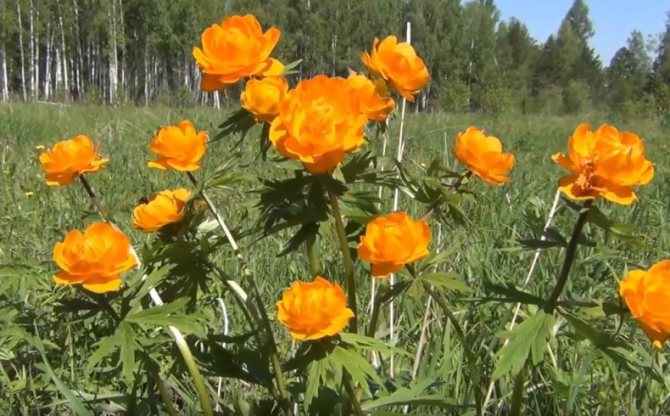

General description of the plant
The bather is well known to botanists, and therefore has a detailed description. According to him, this plant is a perennial shrub belonging to the buttercup family. Its small bush has a height of 50-100 cm. On its stems 1-2 large flowers in the form of a ball grow.
In these flowers, the petals have a glossy finish, similar to varnish. Their color is bright orange, lemon or golden yellow.The flowering time of the plant falls from May to June, there are varieties that bloom in other summer months. Flowering takes place annually for 18-25 days.
A plant such as a bather has several varieties, which have their own description. The following swimsuits are common in our country:
- asian;
- Altai;
- Chinese;
- Ledebour;
- dwarf;
- stemless;
- European;
- cultural.
For example, the Asian swimsuit is distinguished by the orange color of its flowers, the diameter of which is 14 cm. It blooms in May. The plant itself does not exceed 18 cm, its stem is straight, covered with leaves of a finger-split type of dense green color.
The European swimsuit is most common in our country in its European part. Its height is 50 cm, leaves are up to 3 cm in diameter. They have from 3 to 5 lobes, while the lower ones are long-petiolate. This species blooms in May - June. The flower itself is golden yellow in color and consists of a relatively large number of sepals arranged pyramidal.
Important! It is also worth noting the fact that the European swimsuit is listed in such a document as the Red Book, so if you want to harvest it for medicinal and other purposes, leave about 10-20% of the plants in the collection area.
This will allow the population to recover quickly enough. In addition, you can also grow such a species as the cultured swimsuit. This name is understood as hybrids of garden varieties and forms that have large flowers of the most varied colors.
Advice! Cultivation of cultural forms will allow you to satisfy your needs and not harm nature. In addition, from a decorative point of view, they are more preferable than wild ones. As a result, they can be used in more landscape design compositions.
Growing on your site
Now the lights are very popular among gardeners. All thanks to their advantages. Consider how to propagate a plant, as well as the rules for caring for it.
Reproduction
Now very often these flowers began to be planted on their site. Of course, the easiest way is to dig up seedlings and transplant them yourself or buy ready-made seedlings. But if this is not possible, you will have to grow the plant with seeds. However, the lights also have a drawback - seed germination rate is low... It is best to sow seeds in the fall.
You can do this in the spring, but then seed stratification is needed. To do this, you need to keep the seeds in the sand at a temperature of 3-5 degrees for 3 months. In March, seeds can be sown in a greenhouse or boxes, sprinkling with earth. Seedlings will appear in a month. Plants dive if necessary. In the 3rd - 4th year, the lights bloom. By the way, swimsuits are planted in nests of several pieces at a distance of about 50 cm from each other.
Since the lights are an unpretentious plant, caring for them is not at all difficult.
The plant needs watering during a drought. And also you need to regularly carry out weeding from weeds, loosening, fertilizing with mineral and potash fertilizers every 5 years, and pruning is also necessary for the flower.
When and how it blooms
Whether it is a white, yellow or orange swimsuit, this plant blooms very beautifully. Moreover, most varieties have a light sweetish aroma.
Types of flowers
In culture, there are varieties with regular or double flowers, consisting of five or 9-10 petals.
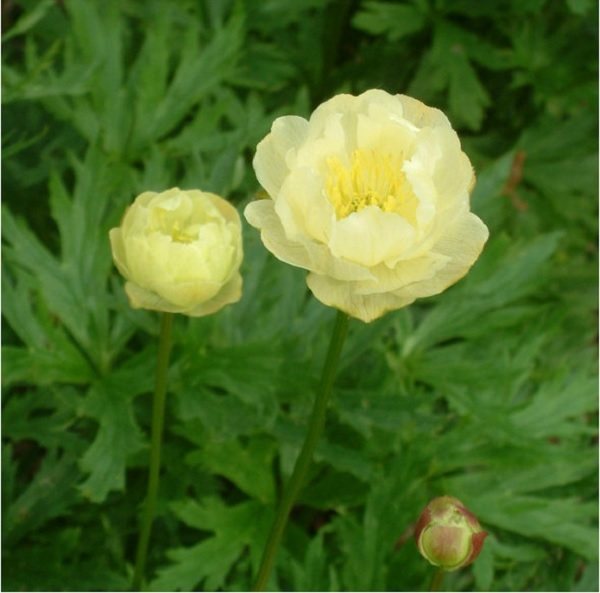

Leotard variety Alabaster
Flower shapes
The perennial swimsuit grass has only one flower shape - spherical. But the flowers can be half-open or open.
Flowering period
When a garden bather blooms, it depends on the particular variety. Most of them open flowers in the second half of May. In general, the flowering period lasts 3-4 weeks. Some varieties are pleasing to the eye until the end of July.
Changes in care during flowering
This plant is notable for its unpretentiousness, but when the swimsuit blooms, it does not require special care, with the exception of one nuance.
Important! Experienced gardeners recommend sprinkling the plant with epin at the very beginning of this period. It is a versatile adaptogen.
Swimsuit contraindications
This type of plant is toxic, so you need to be careful about taking it, if you do not follow the dosage, the nervous system may be affected.
It is very important to consult a doctor before use. In cases of plant poisoning, it is very important to take timely measures: rinse the stomach, call an ambulance.
Thus, the bathing suit is one of the best diuretics, anti-inflammatory drugs, which is why traditional medicine appreciates it, with its help you can cure scabies, also get rid of dropsy, and reduce the symptoms of epilepsy. Despite all the useful properties of the swimsuit, you need to remember that this type of plant is poisonous, it is prohibited to independently treat it with the help of decoctions, infusions and tinctures based on the bathing suit, only after the recommendation of a specialist.
Vulnerability to diseases and pests
Since the bather is a wild-growing flower, even garden varieties are very resistant to temperature changes and to various pests and diseases. It is extremely rare that this plant can be affected by smut, septoria or penetrating short-bodied nematode.
Nevertheless, for better decorativeness and for prevention purposes, it is good to follow some simple measures and adhere to care.
To prevent your beauty from being attacked by a fungus, old leaves must be removed regularly (and especially in autumn).
In addition, the soil can be sprinkled with ash - it will serve as an additional fertilizer and repel insect pests. And when flowering begins, you can spray the stems and leaves with epin, a drug that stimulates the protective functions of the plant and helps to adapt to various conditions.
Purple swimsuit (Trollius lilacinus)
The purple swimsuit grows in the highlands of the Tien Shan, Altai.
This plant is one of the first to bloom near the snowfields that begin to melt, on mossy meadows, it loves an abundance of moisture.
Where does such a sonorous name come from? There are several versions on this matter: translated from Latin it means "bowl", which is also plausible, the flower really has a cup-shaped shape. The swimsuit is called so because in nature it likes to settle where there is moisture: near a river or by a stream. Moreover, flowering coincides in time with the pagan holiday of Ivan Kupala.
In ancient times, for the Eastern Slavs, it was associated with the summer solstice. And it is very symbolic that the peak of the flowering of a solar plant occurred just during this period. But the swimsuit has many other names: Siberian rose, trollius, light, hot, kupava.
How to grow a flowering shrub on your site
It is customary to plant in the garden not wild-growing species, but hybrid varieties. They were bred from European, Asian, Chinese and Altai swimwear. Conventionally, all of them are united under the general name of a cultural or hybrid swimsuit (this includes the varieties Alabaster, Princess, Golden Queen). These species are distinguished by a variety of shades compared to wild and larger flowers, sometimes even double ones.
Flower care is simple, due to the unpretentiousness of the plant.
But always remember one rule of paramount importance - a meadow beauty needs constant soil moisture. In dry soil, it will simply die.
Not only regular watering will help you, but also humus or peat mulch, which retains moisture well in the soil.
Also, careful care involves fertilizing the earth with humus and loosening it with sand. The acidity of the soil should be neutral.
Make sure that your shrub is not surrounded by weeds. You can achieve a second flowering, for which you need to cut out the faded peduncles.Leaves need to be cut only in the fall, since they will be a wonderful decoration in the garden all summer long, even when the flowering has already ended.
The place for a flower can be identified as semi-shady, although it grows well under the open sun. Indeed, in nature, meadows and hills are generously illuminated and warmed by sunlight all day long.
How to propagate a culture
Bushes can be propagated by seeds, cuttings, and by dividing the bush. Overgrown bushes are divided in late spring or autumn, but it is also possible in summer. For this purpose, strong plants are selected that will grow well further.
For division you need:
- remove the bush from the ground, remove the remnants of soil from the roots and wash them in water;
- cut the rhizome into pieces with a knife, leaving 3 or 4 buds on the separated parts. Small parts of the bush will take longer to take root;
- treat the cutting sites with ash or a pale solution of potassium permanganate;
- avoiding drying, plant each part in the soil, deepening the bush by 2 centimeters, leave a gap of about 30-40 centimeters between the new small bushes 7-8 pcs. for 1 sq. meter. The next year, these bushes will turn into full-fledged bushes that can bloom profusely.
For propagation by cuttings, spring shoots of a bush and future shoots with a part of the rhizome are taken. They are rooted at the end of spring using a peat mixture, and for root formation they are soaked in a root growth stimulator "Kornevin" or others, but with the same spectrum of action.
If propagated by seeds, they are usually sown immediately after they are removed from the peduncle. This process can be repeated from summer to late fall. Can be sown in a container with a soil mixture of leafy earth, ash, sawdust. Seedlings will appear in the spring, approximately in the second half of May.
They need to be watered, shaded from the unbearable burning sun. When the first true leaves appear, a pick is carried out at intervals between young plants of 8-10 cm. Before the onset of winter, it is recommended to protect the planted from future frosts by one of the available methods.
Bathers planted in a garden or not in a flower bed will bloom in 2-3 years, during this time they are transplanted to a place where they will grow constantly. The seeds of the crop can also be sown in late spring, if the thermometer shows a temperature of 2-4 degrees above zero, for 3 or 4 months.


Orange and yellow groups of sunny flowers of swimsuits look beautiful against the background of a reservoir in the form of a pool, stream, fountain or pond. Border options, such as the dwarf swimsuit, are perfectly combined with periwinkle against the background of an ensemble of stones.
At the end of the flowering period, when the plants become withered, the yellowed leaves are removed, the root rosette will grow back in the fall. Because of this feature, flowers such as hosts, irises, daylilies should be used. It will be good to combine a swimsuit with flowers blooming with her at the same time. Speaking of shrubs, the neighborhood with a low-growing variety of Japanese spirea or Mahonia holly will be successful.
Leotard trimming
Leaves of the swimsuit remain decorative throughout the growing season. In September - early October, they die off.
Only after dying off, the leaves are cut off, and the base of the petioles remains 2-3 centimeters above the earthen surface. This is the protection of the bud located in the center of the rosette shoot, from which the peduncle appears the next year.
If the leaves are cut on a plant that has not yet completed its growing season, it will significantly weaken the bud. The next year, a well-developed peduncle will no longer work.
Asian swimsuit: description, distribution, growing a flower
Lights (swimsuit) is a perennial plant with very beautiful yellow or bright orange flowers.
The people call the swimsuit lights, but it also has other names: Siberian rose, bells, balabolki, troll flower, frying.The flowers of Siberia, by the way, have an interesting legend associated with one of their names: the lights are called the flower of trolls, because forest dwarfs brew their magic potion of life in these flowers.
Consider everything about this amazing flower: types and varieties, characteristics, advantages, growing on the site (reproduction and care).
Video: Big Breakfast
The plant propagates by dividing the bush, the seeds germinate poorly. After you dig up the bush, you do not need to shake off the ground from it, because the root will be damaged, and the plant will not take root after planting. The bather grows best in one place, it does not need to be constantly replanted. If you decide to do this, then the best time of the year is mid-summer, then the plant is calm. It is best to dig up the bush with a sharp knife. All plant varieties bloom in large numbers every year. The swimsuit is frost-resistant, so there is no need to specially hide it from winter.

